
The average American adult with a bachelor’s degree earns nearly $22,000 more per year than the average adult with just a high school education. In addition to a higher earning potential, a college education has many intangible benefits, including critical thinking skills, exposure to new ideas, and a formative social experience.
Just as a college education impacts the life of an individual, it can also have broad social and economic implications. Cities with highly educated populations tend to have much in common, including high concentrations of wealth and healthy job markets.
24/7 Wall St. reviewed the share of adults with a bachelor’s degree at the metropolitan area level to identify the most educated city in each state. Bachelor’s degree attainment rates range widely between the cities on this list, from 23.3% to 63.2%. For reference, 32.0% of adults nationwide have a bachelor’s degree or higher.
All of the cities on this list are home to multiple higher education institutions, many of which are major research universities.
Click here to see the most educated city in every state.
Click here to see our detailed findings and methodology.

Alabama: Huntsville
> Adults with a bachelor’s degree: 38.8%
> Median household income: $61,331
> Unemployment rate: 3.6%
> Number of colleges and universities: 11
Just 25.5% of adults in Alabama have a four-year college degree, well below the national college attainment rate of 32.0%. Although it is one of the least educated states, not all parts of Alabama have low educational attainment. In three major metro areas, more than one in every three adults have a bachelor’s degree. In Huntsville, 38.8% of adults do, the largest share in the state.
High tech industries in Huntsville require a highly skilled, well-educated workforce. Nicknamed “Rocket City USA,” Huntsville, which is where the rocket that carried the first U.S. satellite into orbit was built. The city is also home to a NASA field center and the U.S. Space and Rocket Center. The metro area is also home to research institutions Alabama A&M University and University of Alabama in Huntsville, as well as Cummings Research Park — a consortium of over 300 companies, largely in science and technology fields.
[in-text-ad]
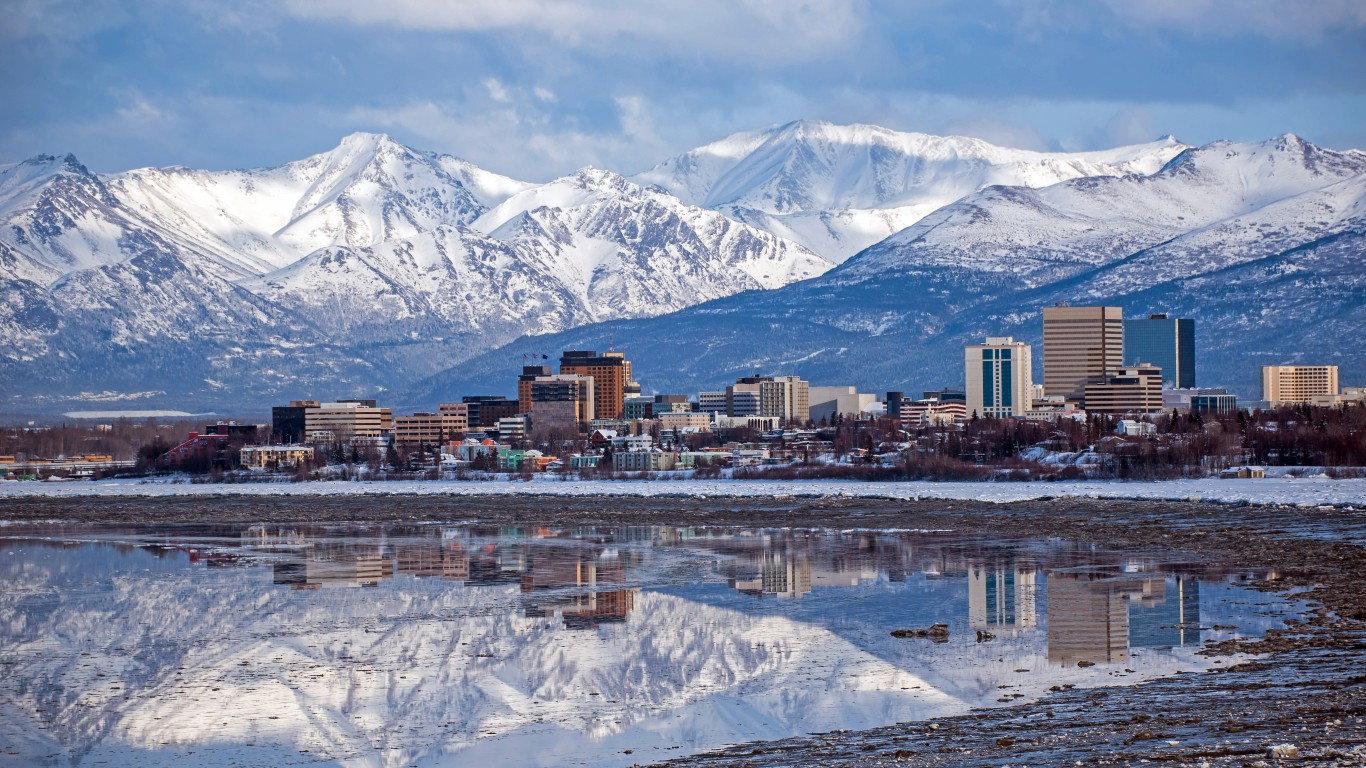
Alaska: Anchorage
> Adults with a bachelor’s degree: 31.6%
> Median household income: $76,871
> Unemployment rate: 5.8%
> Number of colleges and universities: 5
Both Anchorage and Fairbanks, the only two metro areas in Alaska, are home to a larger share of college-educated adults than the state as a whole. While just 28.8% of adults across Alaska have a bachelor’s degree or higher, 29.6% of adults in Fairbanks and 31.6% in Anchorage do. Anchorage, the best-educated city in the state, also has the highest concentration of wealth. While the median household income of $76,871 a year aligns closely with the median income in Fairbanks, 8.1% of households in Anchorage earn at least $200,000 year, well above the 6.8% share of households in Fairbanks. For reference, 7.3% of Alaskan households and 6.9% of American households earn $200,000 or more per year.

Arizona: Flagstaff
> Adults with a bachelor’s degree: 37.3%
> Median household income: $54,893
> Unemployment rate: 5.3%
> Number of colleges and universities: 4
In Flagstaff, 37.3% of adults have at least a bachelor’s degree, by far the largest share of Arizona’s seven metro areas. For reference, just 29.4% of adults across the state as a whole have a four-year college degree.
Cities with a well-educated population often have higher income inequality, and Flagstaff is no exception. Of all area households, 6.0% earn at least $200,000 a year annually, a larger share than the 5.4% share across the state. Meanwhile, 19.0% of the Flagstaff population lives below the poverty line, a far greater share than the 14.9% of Arizona residents.
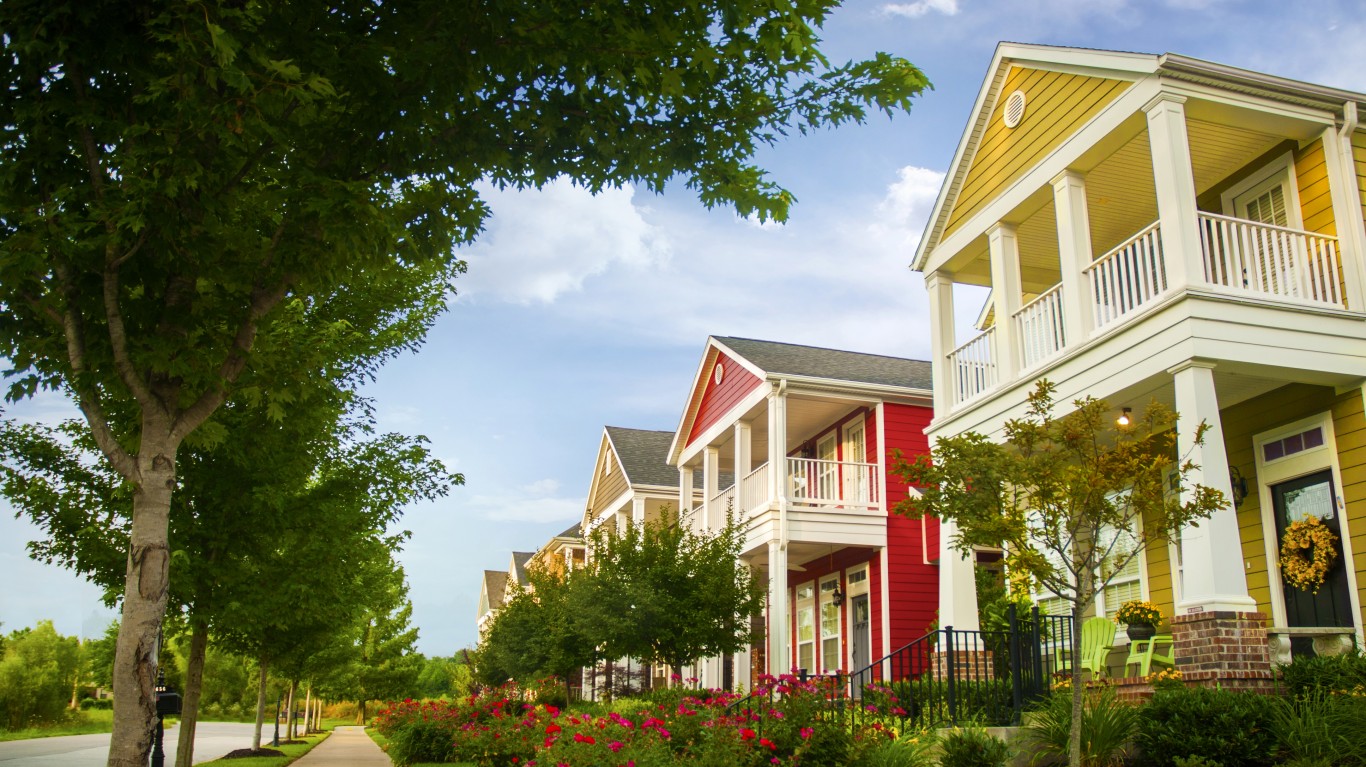
Arkansas: Fayetteville-Springdale-Rogers
> Adults with a bachelor’s degree: 31.8%
> Median household income: $56,038
> Unemployment rate: 2.5%
> Number of colleges and universities: 11
In the Fayetteville-Springdale-Rogers metro area, 31.8% of adults have a bachelor’s degree or higher, well above the college attainment rate across Arkansas of 23.4%. Despite ranking as the best-educated metro area of the six in the state, Fayetteville’s bachelor’s degree attainment rate is lower than the 32.0% national rate.
Areas with higher concentrations of college-educated adults tend report higher incomes, and in the Fayetteville metro area, the typical household earns $56,038 a year, the most of any metro area in the state and well above the statewide median income of $45,869 a year. Still, the median income in Fayetteville-Springdale-Rogers is below the national median of $60,336.
[in-text-ad-2]
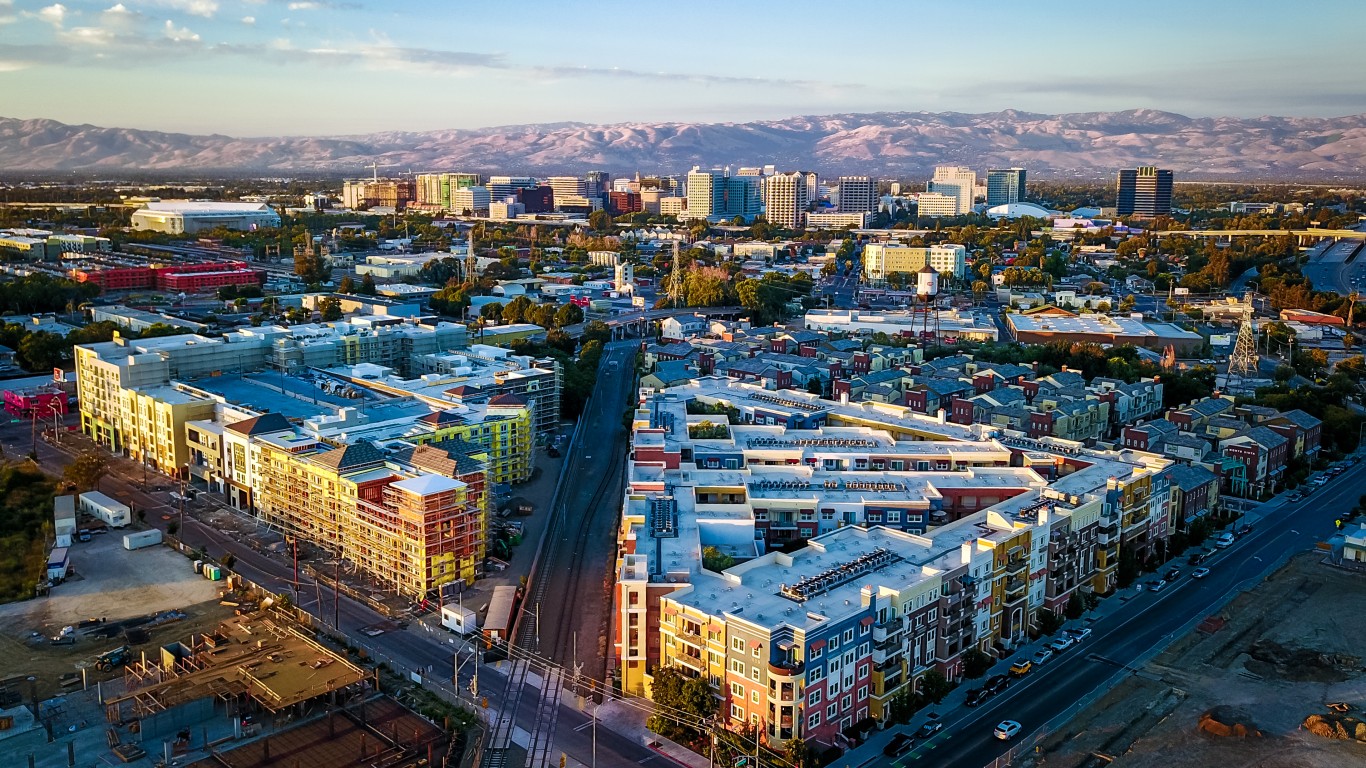
California: San Jose-Sunnyvale-Santa Clara
> Adults with a bachelor’s degree: 50.8%
> Median household income: $117,474
> Unemployment rate: 2.6%
> Number of colleges and universities: 32
San Jose-Sunnyvale-Santa Clara is one of just eight metro areas nationwide — and the only one in California — in which over half of all adults have at least a bachelor’s degree.
A college education can open doors to high skill jobs with high pay — and the San Jose metro area is home to some of the highest earners in the country. More than one in every four area households earn at least $200,000 a year, by far the largest share in the country. Also, the typical area household earns $117,474 a year, well above the median income statewide of $71,805 a year. Major employers in the metro area, commonly known as Silicon Valley, include tech giants Apple, Facebook, and Google.

Colorado: Boulder
> Adults with a bachelor’s degree: 63.2%
> Median household income: $80,834
> Unemployment rate: 2.6%
> Number of colleges and universities: 9
Along with Massachusetts, Colorado is one of just two states where over 40% of adults have a bachelor’s degree. And Boulder, Colorado, the most educated city in one of the best educated states, is also the most educated city in the country. The 63.2% share of metro area adults with at least a bachelor’s degree is nearly double the 32.0% share of American adults nationwide.
Many of the largest employers in Boulder offer jobs that require college education. Companies in and around the city include defense contractors Lockheed Martin and Northrop Grumman, software giant IBM, drug maker AstraZeneca, and hundreds of smaller companies and startups in the aerospace, bioscience, and software fields.
[in-text-ad]

Connecticut: Bridgeport-Stamford-Norwalk
> Adults with a bachelor’s degree: 47.1%
> Median household income: $91,198
> Unemployment rate: 4.2%
> Number of colleges and universities: 20
Connecticut has one of the better educated populations of any state in the country — and all four of the state’s major metro areas are home to a larger share of college-educated adults than the 32.0% national share. In the Bridgeport-Stamford-Norwalk metro area, 47.1% of adults have a bachelor’s degree or higher, the most of any metro area in the state.
Nationwide, the typical adult with a bachelor’s degree earns about $22,000 more per year than the typical adult with a only a high school diploma. In Bridgeport-Stamford-Norwalk, the earnings gap is even greater. The average annual salary among college-educated adults in the metro area is $71,078 a year, about $39,728 more than the average earnings of $31,350 among those with only a high school diploma.
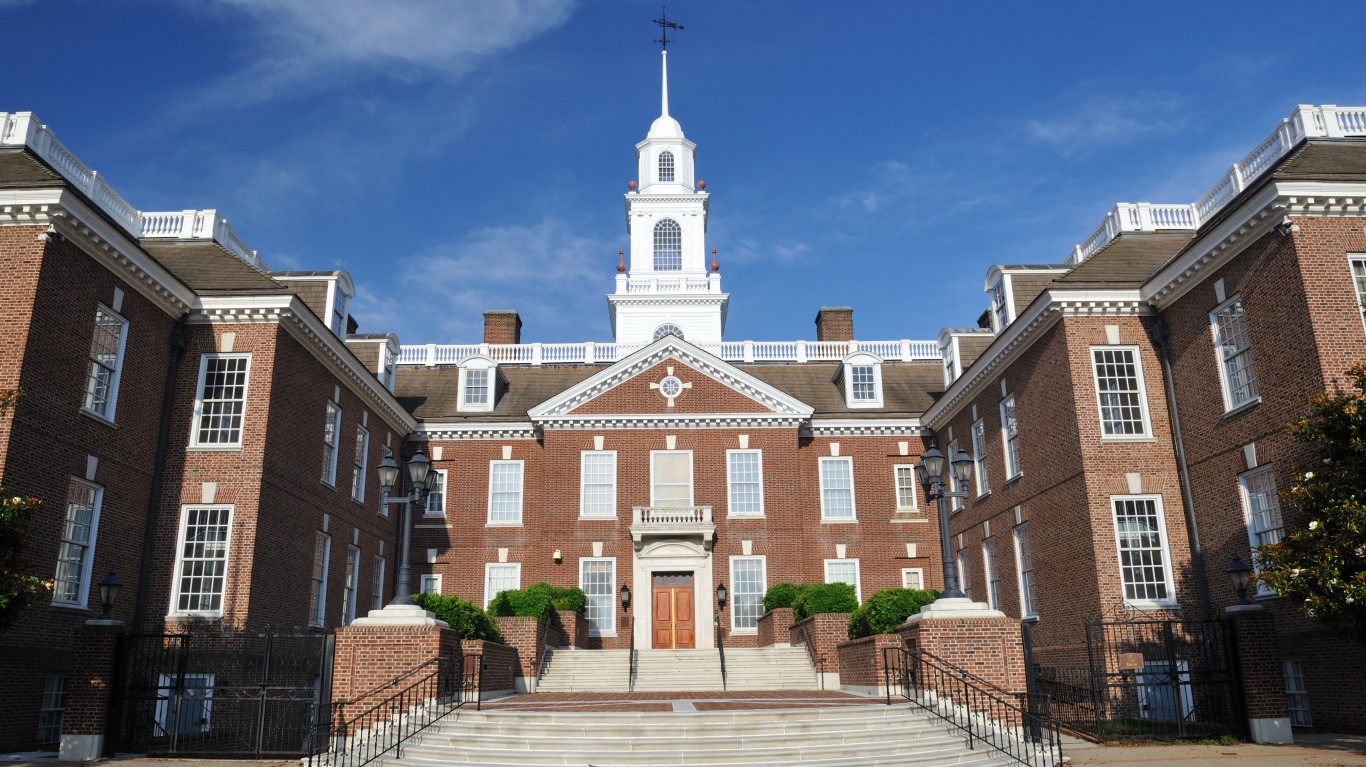
Delaware: Dover
> Adults with a bachelor’s degree: 23.3%
> Median household income: $57,608
> Unemployment rate: 4.5%
> Number of colleges and universities: 5
Dover is the only metro area in Delaware and ranks as the most educated city in the state by default only. It is not, however, very highly educated, and in fact, the bachelor’s degree attainment rate of 23.3% in the metro area is well below the 31.5% rate across the state as a whole.
Adults with college education are often better insulated from economic downturns and often are more attractive candidates to potential employers. In Dover, the low college attainment rate may partially explain the higher unemployment. Some 4.5% of the metro area’s labor force is out of a job, well above the 3.9% unemployment rate across Delaware as a whole.

Florida: Tallahassee
> Adults with a bachelor’s degree: 39.4%
> Median household income: $50,825
> Unemployment rate: 3.5%
> Number of colleges and universities: 8
Across Florida, less than 30% of adults have a bachelor’s degree — a smaller share than the 32% of American adults nationwide. Still, parts of the state are home to high concentrations of college-educated populations. In Tallahassee, for example, 39.4% of adults have a bachelor’s degree or higher, the largest share in the state.
As the state capital, Tallahassee has a high concentration of public sector workers. Government jobs account for 34.0% of all nonfarm employment in the metro area, more than double the typical concentration nationwide.
[in-text-ad-2]

Georgia: Athens-Clarke County
> Adults with a bachelor’s degree: 39.7%
> Median household income: $46,521
> Unemployment rate: 3.3%
> Number of colleges and universities: 3
In Athens-Clarke County, 39.7% of adults have at least a bachelor’s degree, the most of any metro area in the state and well above the bachelor’s degree attainment rate of 30.9% across Georgia as a whole.
Many of the cities on this list are home to multiple colleges and universities — but few are in the same class as Athens as iconic American college towns go. Established in Athens in 1801, 16 years after it was chartered, the University of Georgia is one of the oldest research universities in the United States. The university employs over 3,000 research and instruction faculty — positions that typically require a bachelor’s degree at minimum — and enrolls nearly 8,800 graduate students.

Hawaii: Urban Honolulu
> Adults with a bachelor’s degree: 34.7%
> Median household income: $81,284
> Unemployment rate: 2.0%
> Number of colleges and universities: 22
Urban Honolulu is the only metro area in Hawaii — and the only metro area outside of the contiguous United States — where more than one in every three adults have a bachelor’s degree. The area’s 34.7% bachelor’s degree attainment rate exceeds the comparable 27.0% rate in Kahului-Wailuku-Lahaina, the state’s only other metro area, and the 32.9% rate across Hawaii as a whole.
Well-educated areas also are often wealthy, and Honolulu is no exception. More then one in 10 metro area households earn $200,000 or more a year, compared to 9.1% of households statewide and 6.9% of households nationwide.
[in-text-ad]

Idaho: Boise City
> Adults with a bachelor’s degree: 30.1%
> Median household income: $55,324
> Unemployment rate: 2.8%
> Number of colleges and universities: 21
Of the five metro areas in Idaho, Boise is the only one where over 30% of adults have a bachelor’s degree. Statewide, 26.8% of adults have a bachelor’s degree. As is the case in many cities on this list, Boise has a dense concentration of higher education institutions. There are 21 colleges and universities in Boise — by far the most of any metro area in the state — which together awarded 8,052 degrees in 2015 alone. Boise State University, the largest school in the metro area and one of the largest in the state, enrolls over 2,700 graduate students.
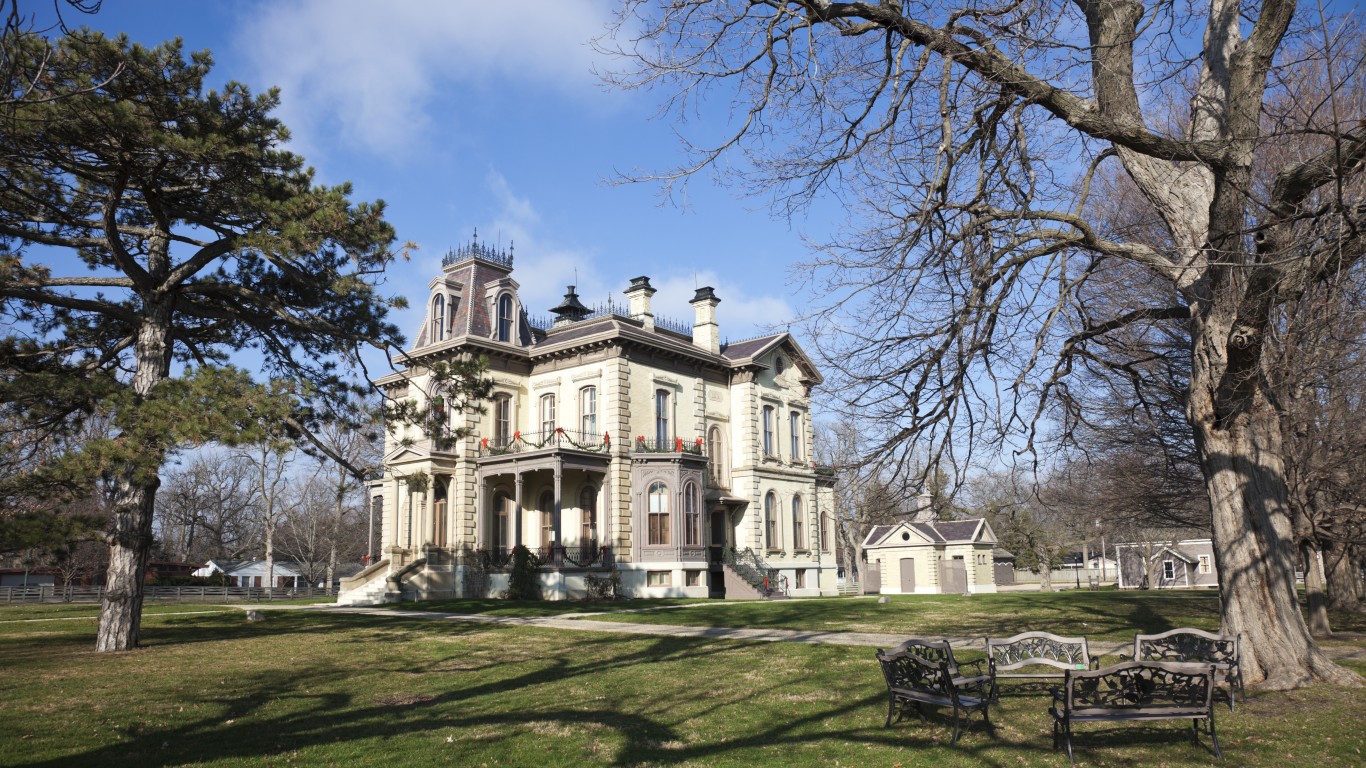
Illinois: Bloomington
> Adults with a bachelor’s degree: 43.1%
> Median household income: $65,936
> Unemployment rate: 3.9%
> Number of colleges and universities: 5
Bloomington is the best educated metro area in Illinois and one of the best educated nationwide. Some 43.1% of area adults have a bachelor’s degree or higher, compared to 34.4% of adults across the state and 32.0% of adults nationwide. Bloomington also has an exceptional high school diploma attainment rate, which at 95.7%, is higher than all but four other metro areas nationwide.
A college education typically opens doors to higher paying jobs, and in Bloomington, a four-year degree pays off even more than usual. The average annual salary for those with a bachelor’s degree in the metro area is $66,497, about $34,900 more than the average salary for those with only a high school education. Statewide, workers with a bachelor’s degree earn $25,482 more than those with just a high school education.
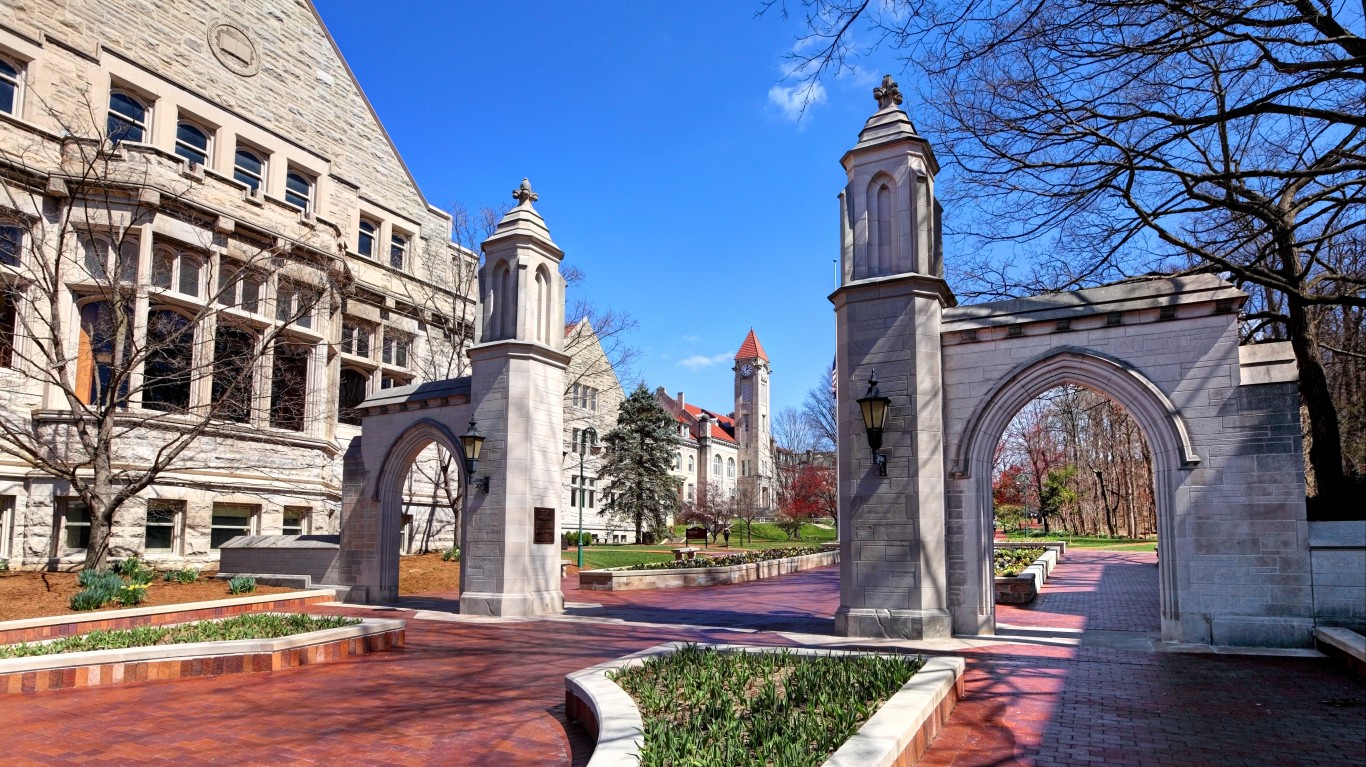
Indiana: Bloomington
> Adults with a bachelor’s degree: 40.9%
> Median household income: $49,043
> Unemployment rate: 3.9%
> Number of colleges and universities: 2
Of the dozen metro areas in Indiana, Bloomington is the only one where over 40% of adults have a bachelor’s degree. More so than most cities on this list, the high bachelor’s degree attainment rate is largely explained by the presence of a major research institution. The Bloomington metro area is home to the flagship campus of Indiana University, the largest four-year higher education institution in the state. The school, which enrolls over 10,000 graduate and professional degree students, issued nearly 11,500 degrees in 2015 alone.
[in-text-ad-2]
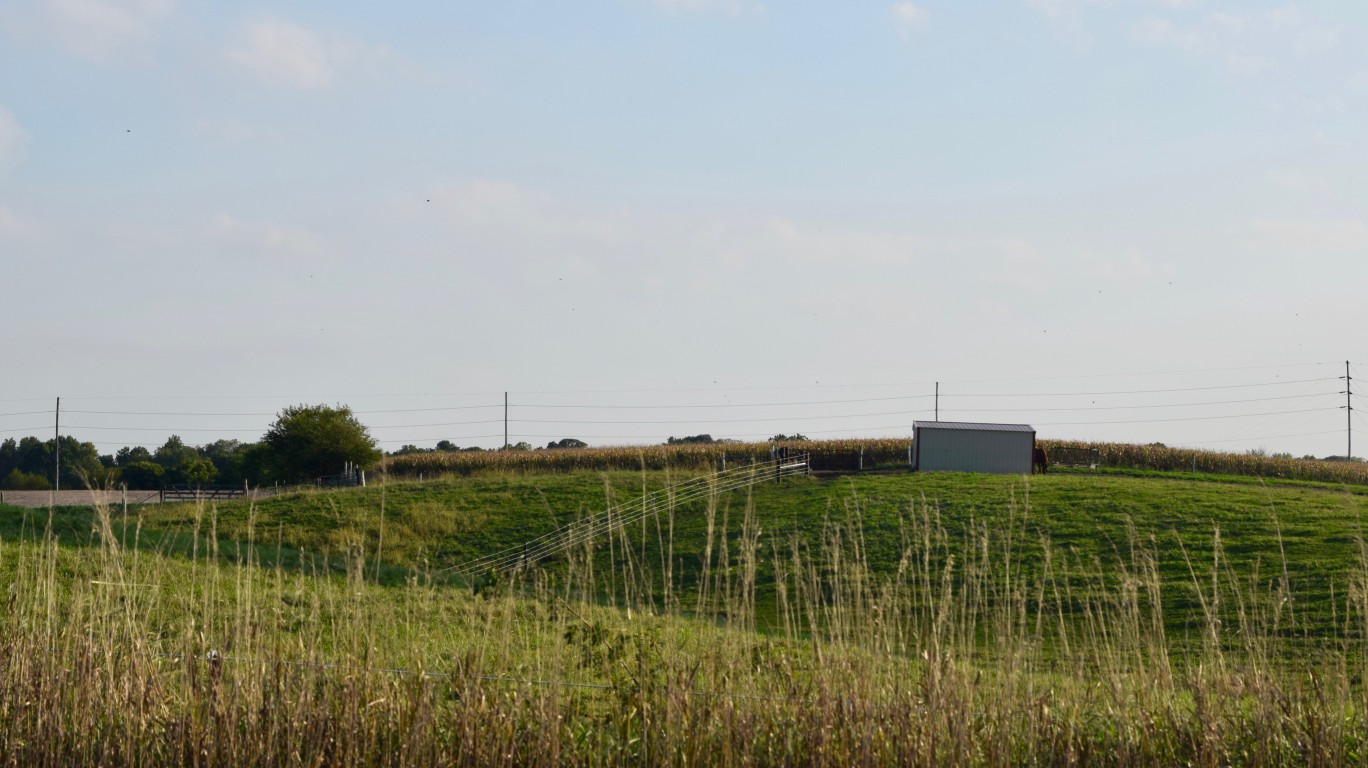
Iowa: Ames
> Adults with a bachelor’s degree: 53.0%
> Median household income: $60,351
> Unemployment rate: 1.5%
> Number of colleges and universities: 2
In Ames, the best educated metro area in Iowa and second best educated in the Midwest, over half of all adults have a bachelor’s degree or higher. The metro area’s 53.0% bachelor’s degree attainment rate is well above the comparable 28.9% state and 32.0% national rates. One of the many college towns on this list, Ames is home to Iowa State University, which awarded more than 7,800 degrees in 2015 alone. As of the fall 2018 semester, the school enrolled nearly 4,800 graduate students.
College-educated adults have access to a wider range of jobs and are better sheltered from economic downturns. In Ames, just 1.5% of the labor force is unemployed, the lowest unemployment rate of any U.S. metro area.
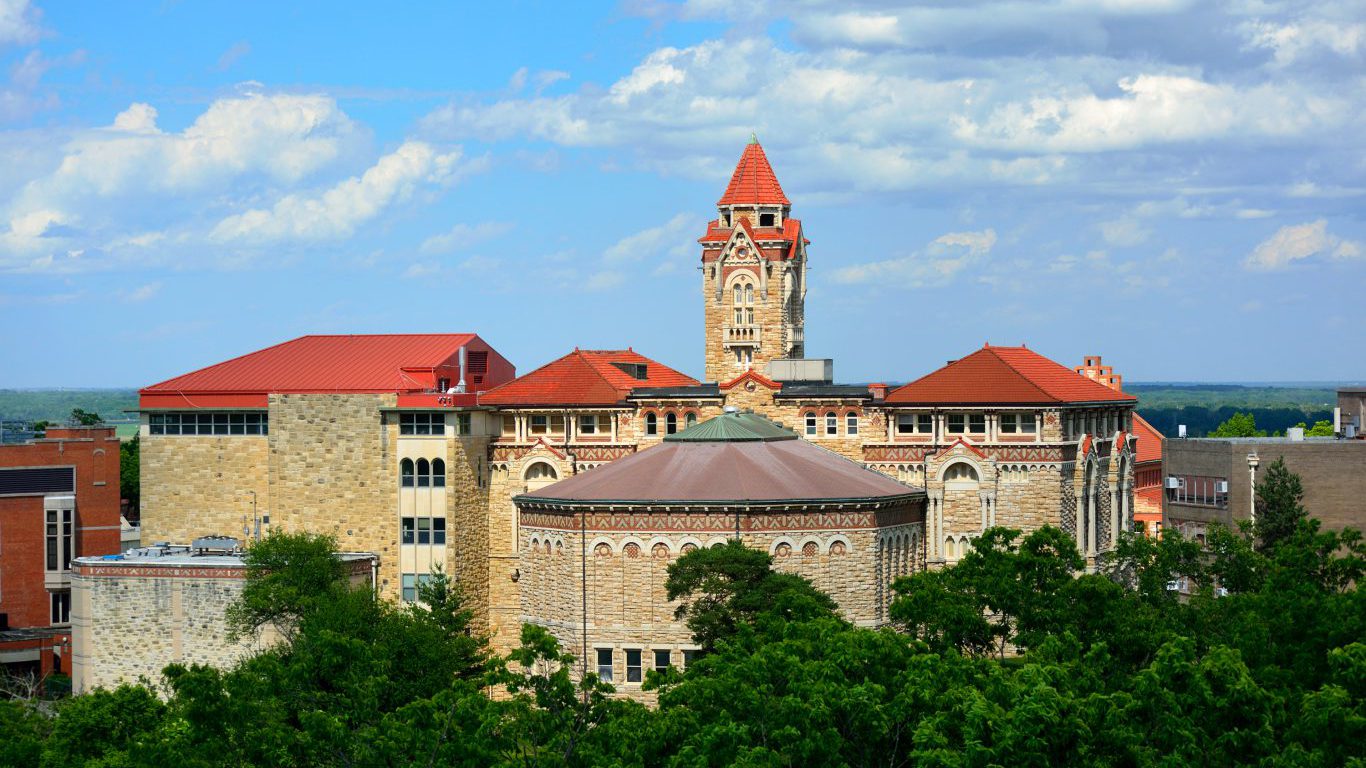
Kansas: Lawrence
> Adults with a bachelor’s degree: 47.3%
> Median household income: $55,646
> Unemployment rate: 3.0%
> Number of colleges and universities: 6
Lawrence’s bachelor’s degree attainment rate of 47.3% is highest in the state. The high educational attainment is bolstered in large part by the presence of the University of Kansas. The largest higher education institution in the state, the university’s Lawrence campus, which enrolls about 5,840 graduate students, awarded nearly 6,700 degrees in 2015.
As is the case in many metro areas on this list, unemployment is low in Lawrence. Just 3.0% of workers in the metro area are out of a job, compared to unemployment rates of 3.4% across the state and 3.9% across the country.
[in-text-ad]
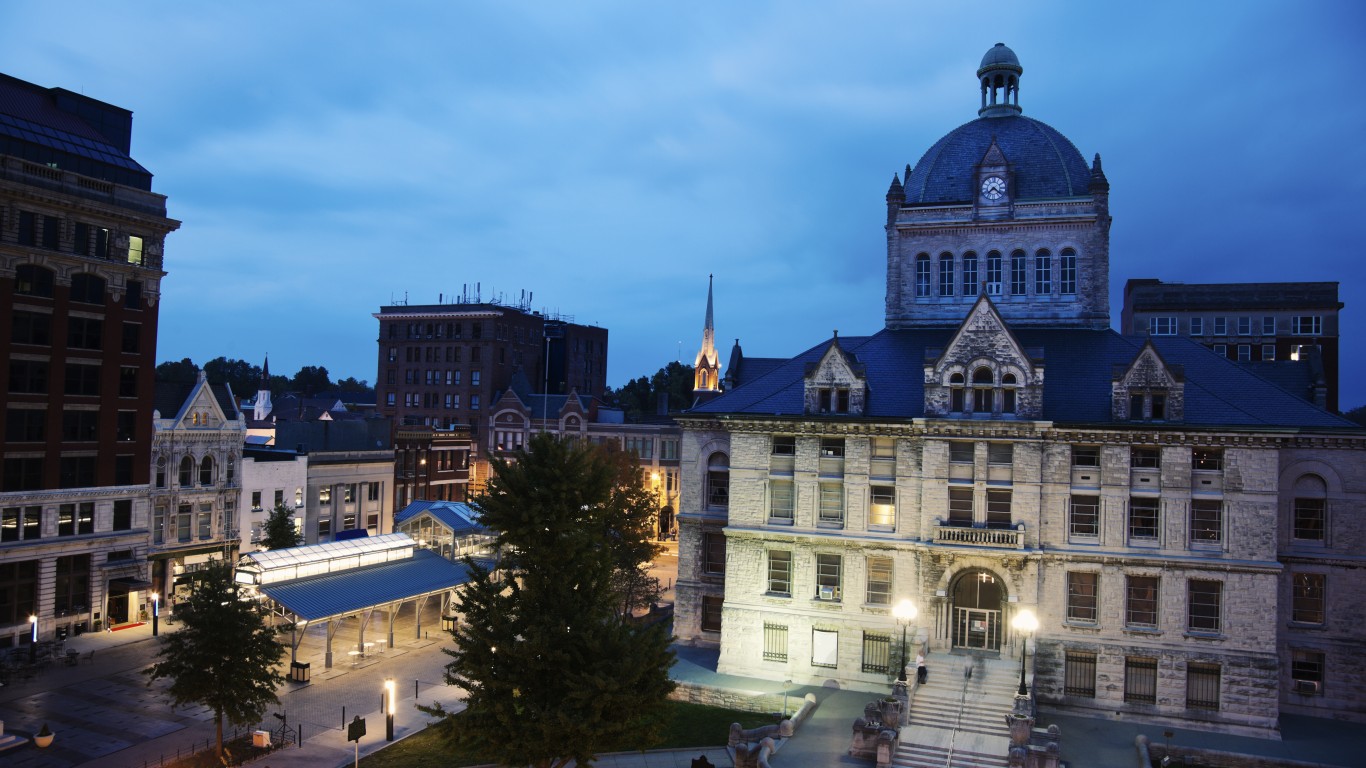
Kentucky: Lexington-Fayette
> Adults with a bachelor’s degree: 37.5%
> Median household income: $58,069
> Unemployment rate: 3.5%
> Number of colleges and universities: 19
Kentucky is one of the least educated states in country — it is one of only half a dozen states where fewer than one in four adults have a bachelor’s degree. Not all parts of the state, however, have low-educational attainment. In the Lexington-Fayette metro area, 37.5% of adults have a bachelor’s degree or higher, the largest share of any metro area in the state and well above the 32.0% share of American adults nationwide.
Well-educated areas often have strong job markets and relatively high incomes. Lexington-Fayette’s unemployment rate of 3.5% is the lowest of any metro area in the state, and the median annual household income of $58,069 is the highest.
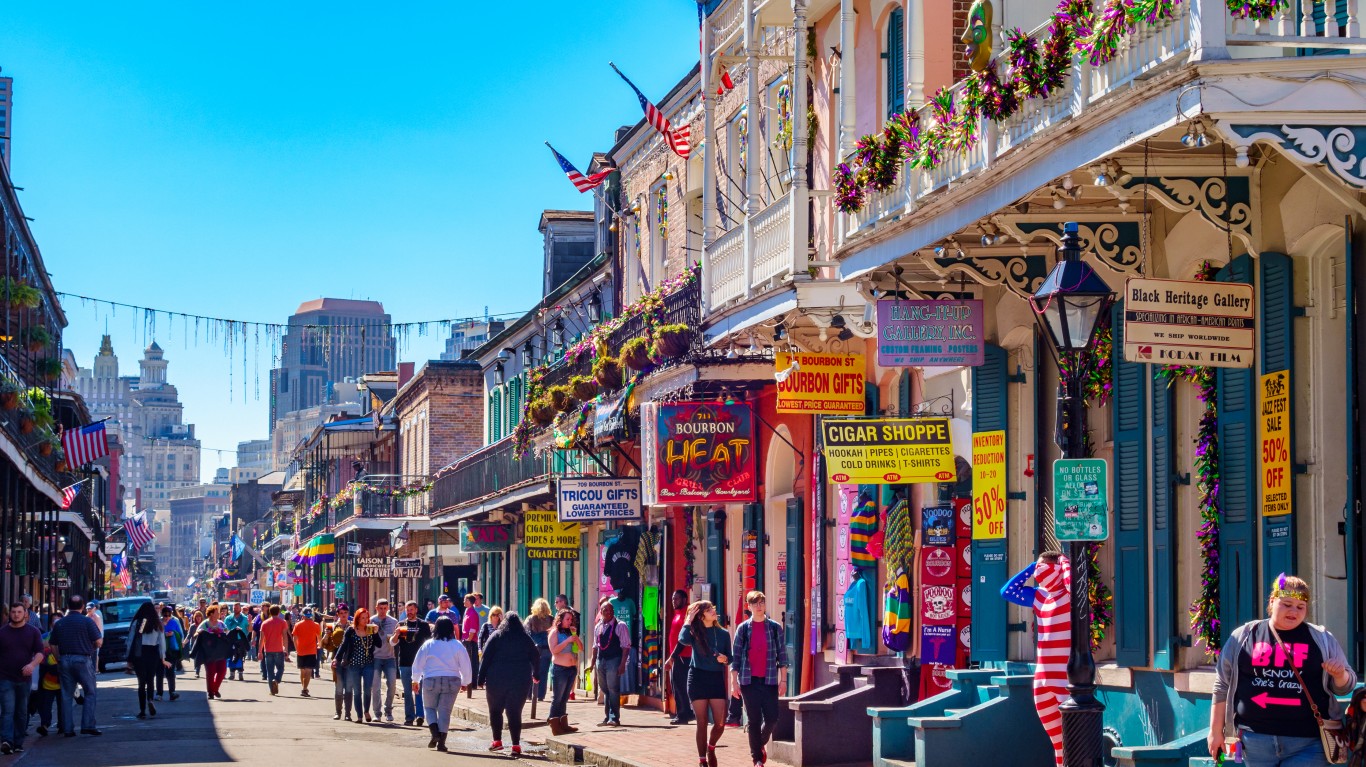
Louisiana: New Orleans-Metairie
> Adults with a bachelor’s degree: 29.5%
> Median household income: $50,528
> Unemployment rate: 4.9%
> Number of colleges and universities: 31
With a bachelor’s degree attainment rate of 23.8%, Louisiana has one of the least educated populations. It is also one of only three states where the bachelor’s degree attainment rate in all metro areas is below 30%. Even in New Orleans, the most educated metro area in the state, just 29.5% of adults have a bachelor’s degree, well below the 32.0% of adults nationwide.
The low bachelor’s degree attainment rate may partially explain some other poor economic measures in New Orleans. For example, the metro area’s unemployment rate of 4.9% and poverty rate of 18.6% are well above the respective nationwide rates of 3.9% and 13.4%.

Maine: Portland-South Portland
> Adults with a bachelor’s degree: 40.5%
> Median household income: $68,570
> Unemployment rate: 2.6%
> Number of colleges and universities: 17
Portland is home to the highest concentration of college educated adults in Maine. The metro area’s bachelor’s degree attainment rate of 40.5% well exceeds the comparable rate of 29.1% in Bangor, the second best educated metro area in the state. Portland-South Portland also has the greatest concentration of wealth in the state. Some 6.4% of area household earn at least $200,000 a year, double the 3.2% of households in Bangor, the second wealthiest metro area in the state.
[in-text-ad-2]
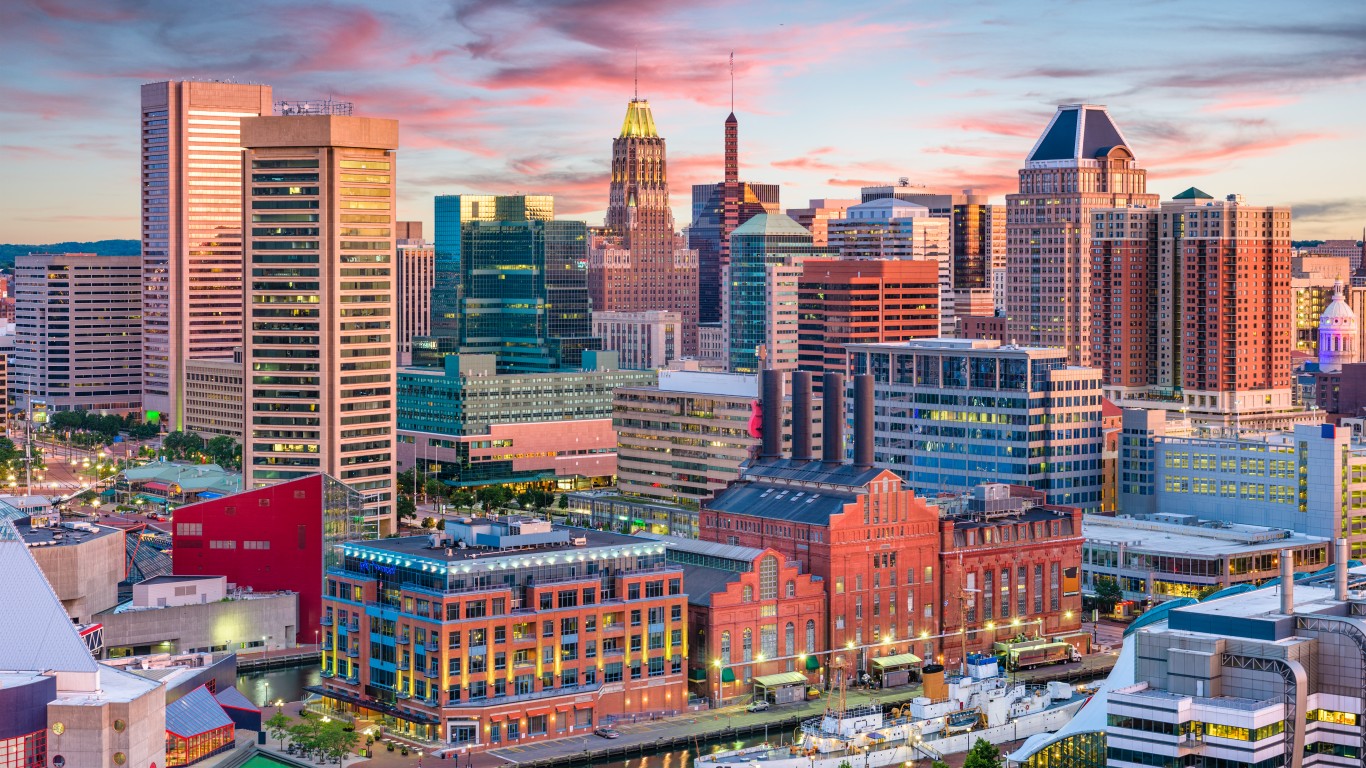
Maryland: Baltimore-Columbia-Towson
> Adults with a bachelor’s degree: 39.5%
> Median household income: $77,394
> Unemployment rate: 4.3%
> Number of colleges and universities: 50
Maryland is a rare example of a state where non-urban areas have higher educational attainment rates than cities. Each of the state’s five metro areas has a lower bachelor’s degree attainment rate than the 39.7% state rate. In Baltimore-Columbia-Towson, the most educated metro area in the state, 39.5% of adults have a bachelor’s degree or higher.
The area’s high bachelor’s degree attainment rate is bolstered by a concentration of colleges and research universities. The metro area’s 50 post secondary institutions awarded over 44,000 degrees in 2015 and include Johns Hopkins University, Towson University, and University of Maryland – Baltimore County.

Massachusetts: Boston-Cambridge-Newton
> Adults with a bachelor’s degree: 47.6%
> Median household income: $85,691
> Unemployment rate: 3.3%
> Number of colleges and universities: 134
Boston-Cambridge-Newton is the best educated metro area in the best educated state. Some 47.6% of metro area adults have at least a bachelor’s degree, compared to 43.4% of adults in Massachusetts and 32.0% of adults nationwide.
The metro area has a high concentration of postsecondary education institutions and well-paying jobs. The 134 colleges and universities in and around Boston awarded more than 100,000 degrees in 2015. These institutions include Boston University, Harvard University, and Northeastern University. Additionally, the typical area household earns $85,691 a year, the second most of any metro area in New England, trailing only Bridgeport-Stamford-Norwalk, Connecticut.
[in-text-ad]
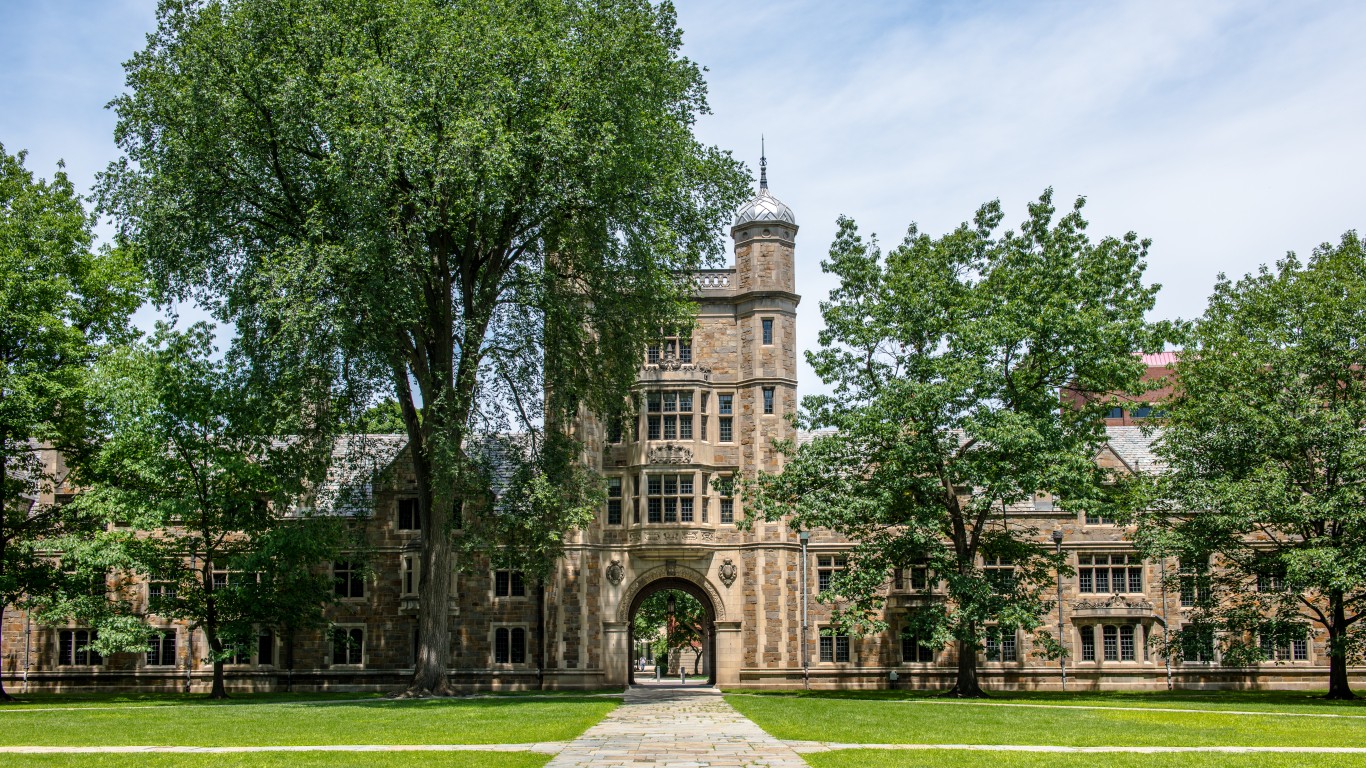
Michigan: Ann Arbor
> Adults with a bachelor’s degree: 54.5%
> Median household income: $70,286
> Unemployment rate: 2.8%
> Number of colleges and universities: 8
One of only eight metro areas where over half of all adults have at least a bachelor’s degree, Ann Arbor is one of several iconic American college towns to rank on this list. Home to eight colleges and universities, including the University of Michigan’s flagship campus, more than 22,400 people earned a degree in Ann Arbor in 2015 alone.
As is the case in many states, Michigan’s best-educated metro area is also its wealthiest. The typical household in Ann Arbor earns $70,286 a year, nearly $9,000 more than the median income in Midland, the second wealthiest metro area in the state.

Minnesota: Minneapolis-St. Paul-Bloomington
> Adults with a bachelor’s degree: 41.7%
> Median household income: $76,856
> Unemployment rate: 2.5%
> Number of colleges and universities: 88
Nearly 42% of adults in the Twin Cities have a bachelor’s degree, the largest share in any of Minnesota’s five metro areas. The largest metro area in the state, Minneapolis-St. Paul-Bloomington also has the most postsecondary education institutions. The area’s 88 schools, which include the University of Minnesota, the largest university in the state, awarded 66,710 degrees in 2015.
College graduates in the Twin Cities benefit financially from their education more than graduates in most other areas in the state. The average salary for workers with a four-year degree in the area is $60,813 a year, $26,889 more than the average salary for workers with only a high school diploma — the largest earnings difference of any metro area in the state.

Mississippi: Jackson
> Adults with a bachelor’s degree: 30.5%
> Median household income: $52,434
> Unemployment rate: 4.0%
> Number of colleges and universities: 5
Just 21.9% of adults in Mississippi have a bachelor’s degree, the second smallest share of any state, trailing only West Virginia, and well below the national bachelor’s degree attainment rate of 32.0%. However, MIssissippi’s urban areas are slightly better educated than the state as whole. In the Gulfport metro area, 23.4% of adults have a bachelor’s degree. In both Jackson and Hattiesburg, the state’s two other metro areas, 30.5% of adults have a bachelor’s degree. While the bachelor’s degree attainment rates are identical in Jackson and Hattiesburg, Jackson ranks as the most educated city because, with a population nearly quadruple that of Hattiesburg, far more college-educated adults live in and around the state capital.
Like many other metro areas on this list, Jackson also has the lowest unemployment rate and highest median household income of any metro area in the state.
[in-text-ad-2]
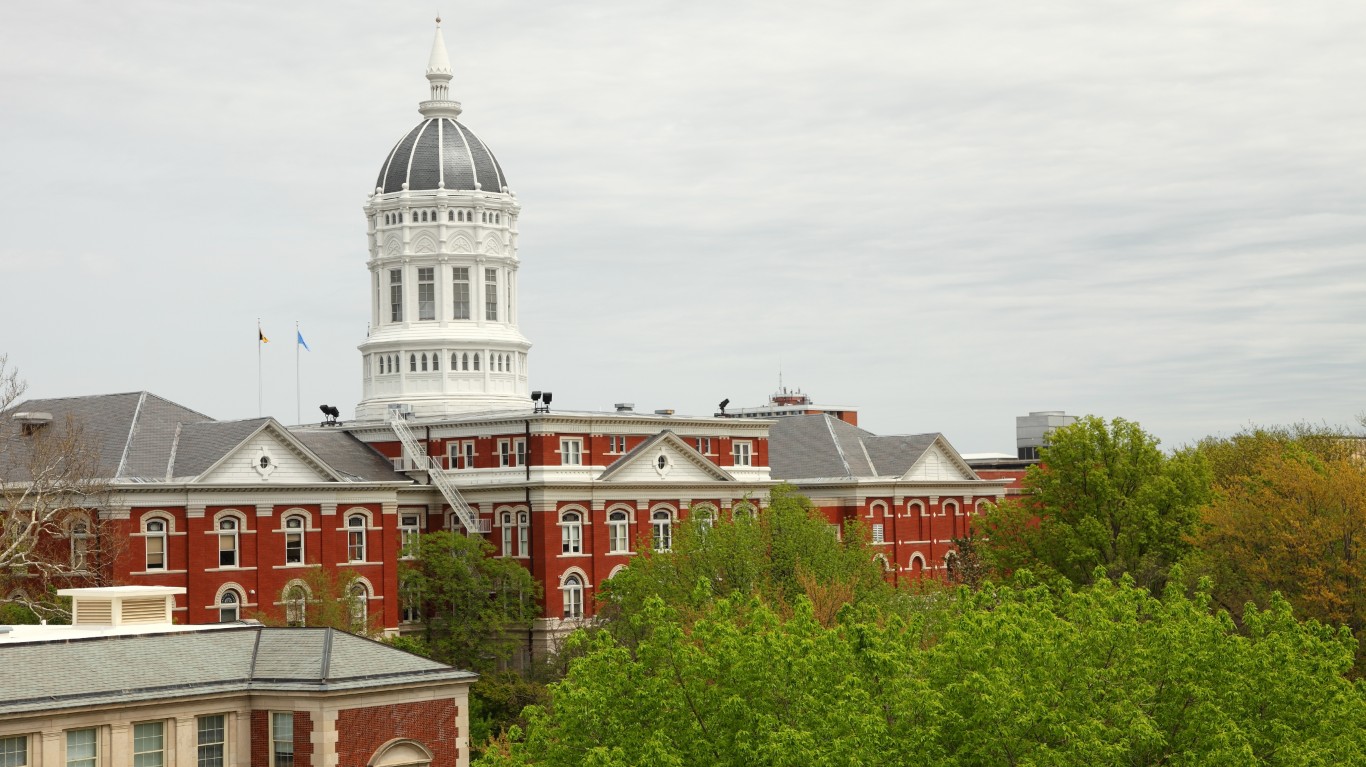
Missouri: Columbia
> Adults with a bachelor’s degree: 45.7%
> Median household income: $51,340
> Unemployment rate: 2.3%
> Number of colleges and universities: 7
Columbia’s bachelor’s degree attainment rate of 45.7% is the highest in Missouri, one of the 10 highest in the Midwest, and among the 20 highest of any metro area nationwide.
A well-educated population translates to a skilled workforce, which can attract new businesses and ultimately serve as a solid foundation for a strong job market. Columbia’s 2.3% unemployment rate is the lowest of any metro area in the state and well below the 3.4% state and 3.9% national unemployment rates.
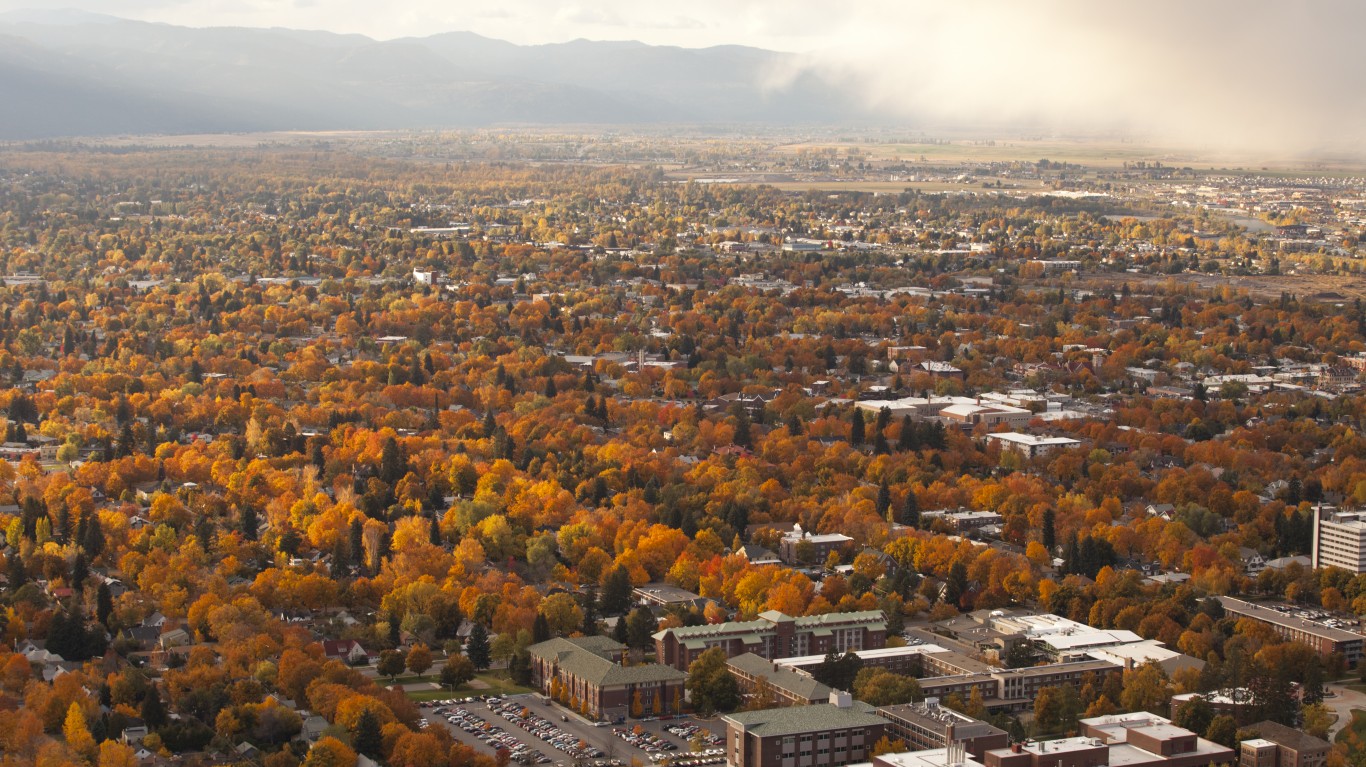
Montana: Missoula
> Adults with a bachelor’s degree: 46.0%
> Median household income: $54,311
> Unemployment rate: 3.2%
> Number of colleges and universities: 2
Missoula is the best educated metro area in Montana. Some 46.0% of metro area adults have a bachelor’s degree or higher, over 10 percentage points higher than the bachelor’s degree attainment rate of 32.3% statewide and the 32.2% rate in Billings, the metro area with the second highest bachelor’s degree attainment rate in the state.
Workers with a college education typically have access to higher paying jobs — and Missoula has the highest concentration of wealth of any metro area in Montana. Some 4.2% of area households earn $200,000 or more a year, compared to 3.5% of households statewide.
[in-text-ad]
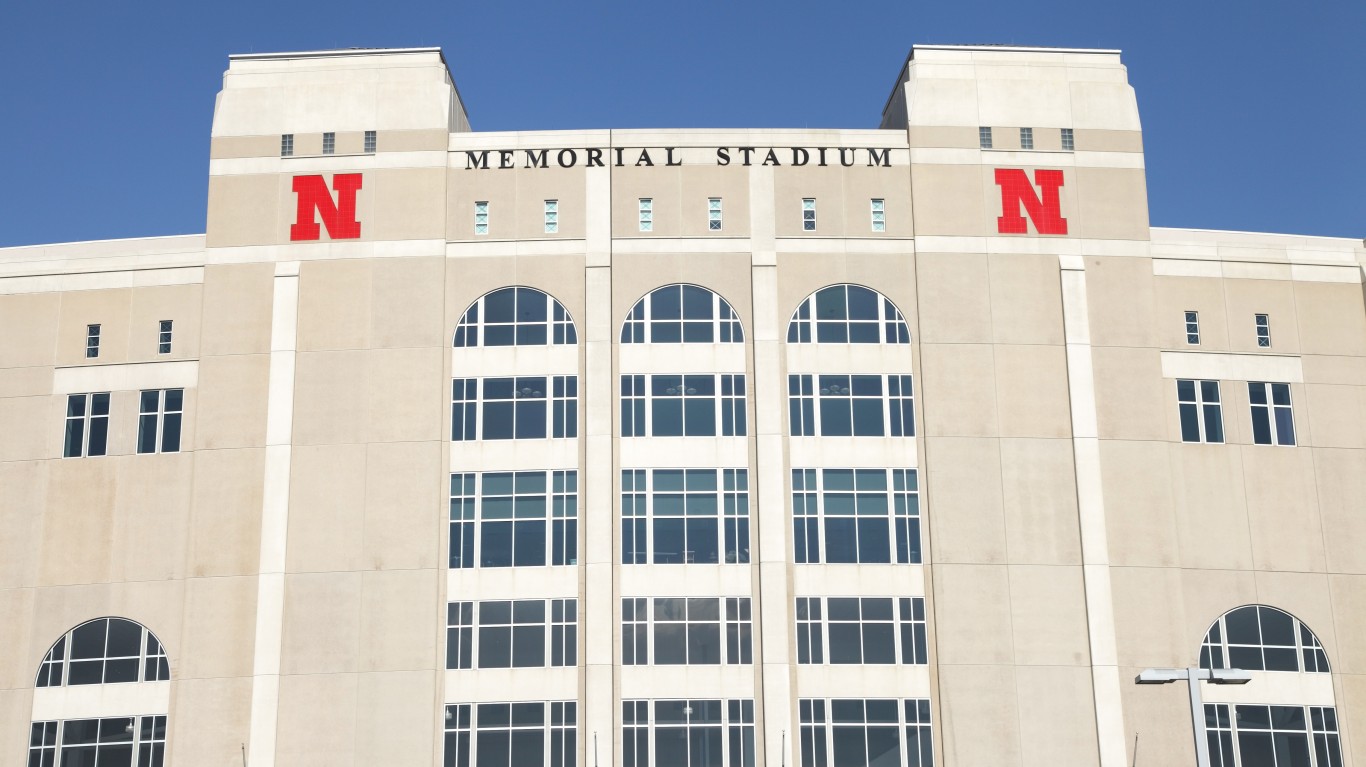
Nebraska: Lincoln
> Adults with a bachelor’s degree: 38.1%
> Median household income: $60,057
> Unemployment rate: 2.6%
> Number of colleges and universities: 13
Lincoln, Nebraska, is one of several iconic college towns to rank on this list. The metro area is home to the flagship campus of the University of Nebraska, the largest postsecondary education institution in the state. The school, which enrolls nearly 5,000 graduate and professional degree students, awarded more than 5,000 degrees in 2015. Partially because many university graduates remain in the Lincoln metro area after graduation — not to mention the school’s 1,705 faculty members in positions that generally require a bachelor’s degree at the very least — Lincoln’s 38.1% bachelor’s degree attainment rate is the highest in Nebraska. Statewide, 31.7% of adults have a bachelor’s degree.
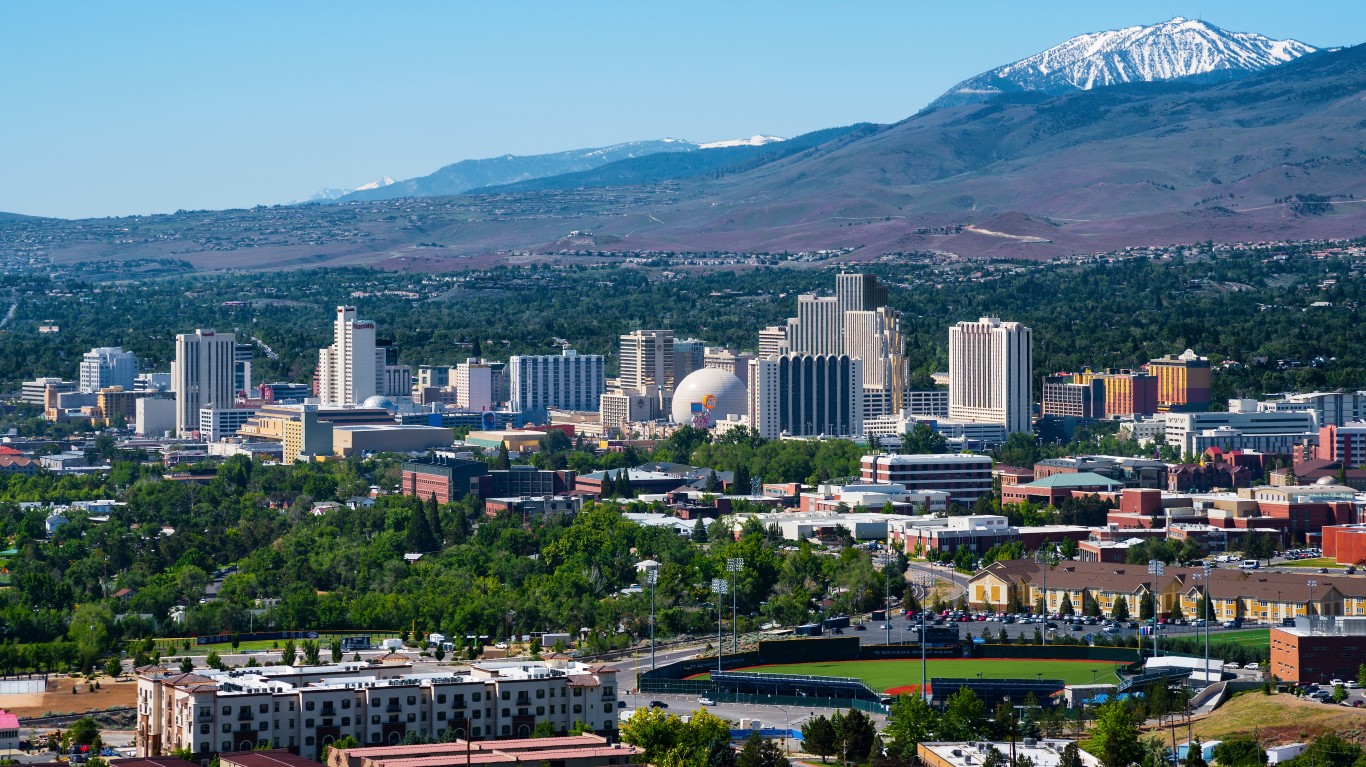
Nevada: Reno
> Adults with a bachelor’s degree: 31.0%
> Median household income: $61,360
> Unemployment rate: 3.6%
> Number of colleges and universities: 13
Reno is the only metro area in Nevada with a higher concentration of college-educated adults than the state as a whole. Reno’s 31.0% bachelor’s degree attainment rate is higher than 24.9% state rate as well as the 24.4% rate in Las Vegas and the 23.7% rate in Carson City.
Workers with a college education typically have access to higher paying jobs — and Reno has the highest concentration of wealth of any metro area in Nevada. Some 6.0% of all area households earn $200,000 or more a year, compared to 4.8% of households statewide.
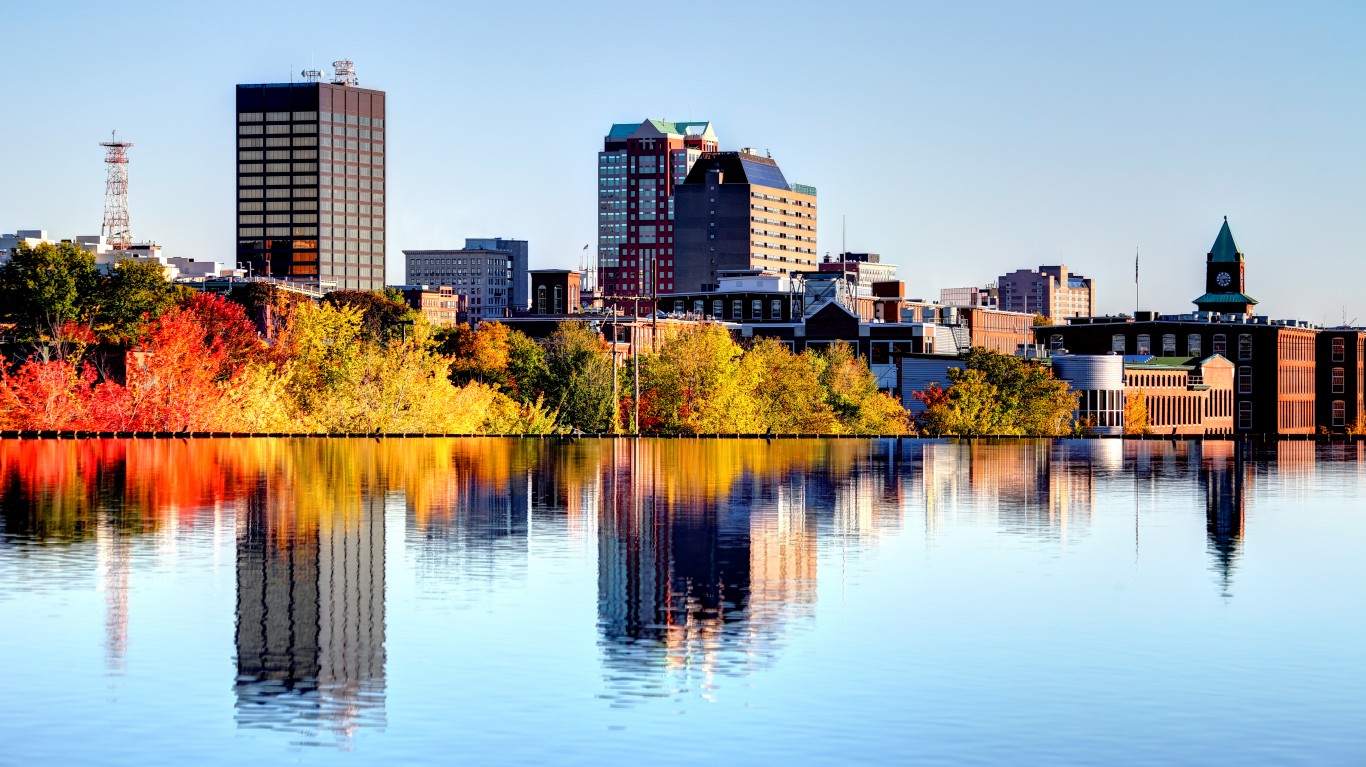
New Hampshire: Manchester-Nashua
> Adults with a bachelor’s degree: 37.6%
> Median household income: $78,769
> Unemployment rate: 2.5%
> Number of colleges and universities: 17
Manchester-Nashua ranks as the best educated metro area in New Hampshire by default, as it is the only metro area in the state. Still, 37.6% of area adults have a bachelor’s degree, a larger share than the 36.9% of adults statewide. Additionally, Manchester’s bachelor’s degree attainment rate is higher than that of most other metro areas in the broader New England region.
Better-educated areas are often high earning, and in Manchester, the typical household earns $78,769 a year, over $5,000 more than the typical household in New Hampshire as a whole.
[in-text-ad-2]

New Jersey: Trenton
> Adults with a bachelor’s degree: 43.9%
> Median household income: $79,173
> Unemployment rate: 3.8%
> Number of colleges and universities: 11
In Trenton, New Jersey’s capital, 43.9% of adults have a bachelor’s degree or higher, the largest share of any metro area in the state by a wide margin. In Ocean City, the metro area with the second highest bachelor’s degree attainment rate, 33.5% of adults have a bachelor’s degree.
Higher educational attainment can open the door to higher paying jobs — and high incomes are relatively common in Trenton. Slightly more than 15% of all metro area households earn at least $200,000 a year, the largest share in the state and sixth largest share nationwide.

New Mexico: Santa Fe
> Adults with a bachelor’s degree: 40.3%
> Median household income: $58,821
> Unemployment rate: 3.7%
> Number of colleges and universities: 7
New Mexico’s bachelor’s degree attainment rate of 27.1% is lower than that of most states. Still, some parts of the state have relatively large college educated populations. In Santa Fe, the state capital, 40.3% of adults have a bachelor’s degree, the largest share of any metro area in the state and well above the 32.0% of adults nationwide.
While those with a college degree are more likely to report higher incomes than those with just a high school diploma, the benefit is relatively small in Santa Fe. The average annual salary for workers with a four-year degree in the metro area is $37,055, only about $6,600 more the average salary for workers with only a high school diploma. Meanwhile, the earnings difference is $15,557 across the state and $21,860 across the United States as a whole.
[in-text-ad]
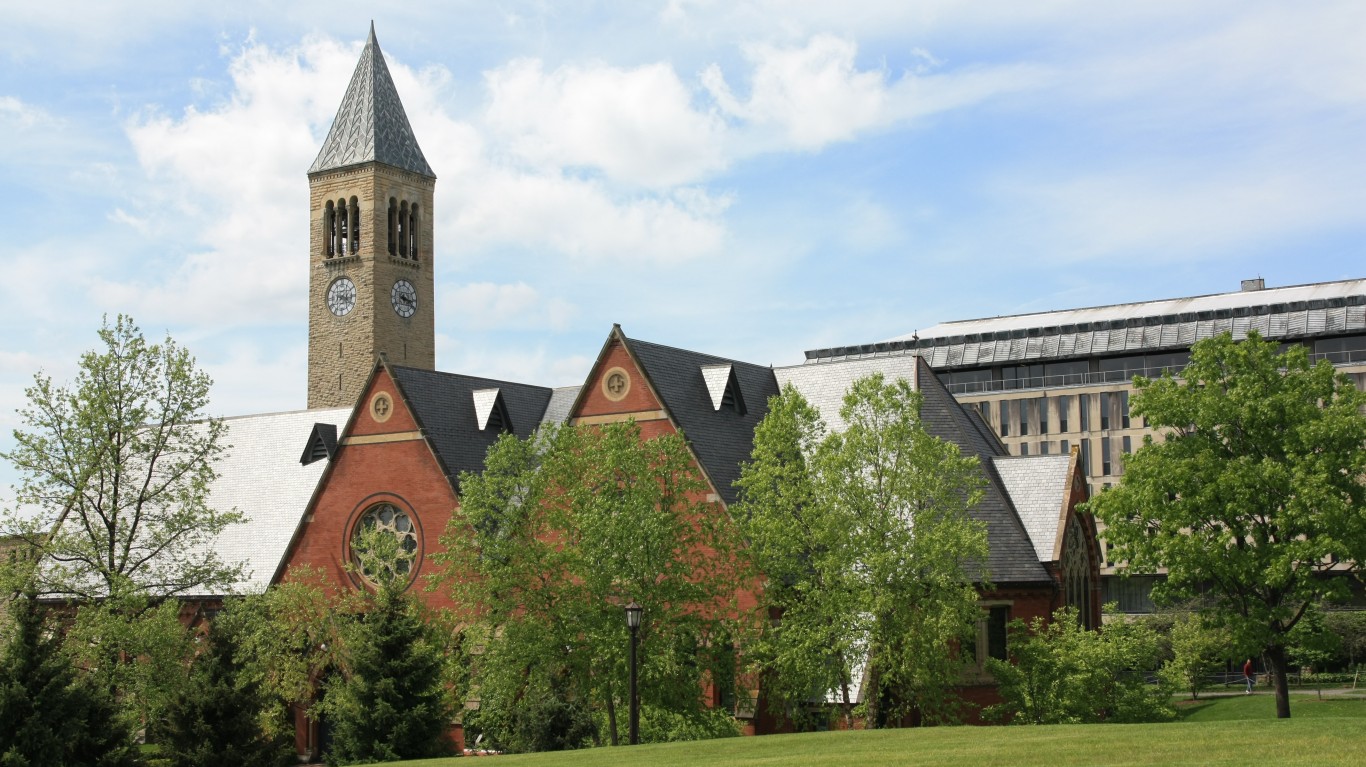
New York: Ithaca
> Adults with a bachelor’s degree: 52.2%
> Median household income: $56,672
> Unemployment rate: 3.6%
> Number of colleges and universities: 4
Ithaca is the only metro area in New York state — and one of only eight nationwide — where over half of all adults have at least a bachelor’s degree. The high educational attainment in the metro area is largely attributable to the presence of Cornell University and Ithaca College, which together issued nearly 9,000 degrees in 2015 alone. Cornell, the largest academic institution in Ithaca, enrolls over 8,000 professional and graduate level students and employs 1,650 faculty members, positions that typically require a bachelor’s degree at minimum. All told, the number of students and faculty at Cornell alone is equal to nearly a quarter of the Ithaca metro area population.

North Carolina: Durham-Chapel Hill
> Adults with a bachelor’s degree: 46.9%
> Median household income: $61,271
> Unemployment rate: 3.4%
> Number of colleges and universities: 17
Many of the cities on this list have high concentrations of college educated adults because of the presence of colleges and universities. Postsecondary institutions employ highly educated instructors and researchers, award hundreds if not thousands of degrees a year, and often offer graduate programs for which a bachelor’s degree is a precondition to enrollment. In addition to Duke University, the Durham-Chapel Hill metro area is home to the University of North Carolina at Chapel Hill, the largest university in the state. The 17 colleges and universities in the area awarded more than 18,700 degrees in 2015 alone.
Currently, 46.9% of adults in the Durham-Chapel Hill metro area have a bachelor’s degree or higher, the largest share of any of North Carolina’s 15 metro areas. For reference, 31.3% of adults statewide have at least a bachelor’s degree.
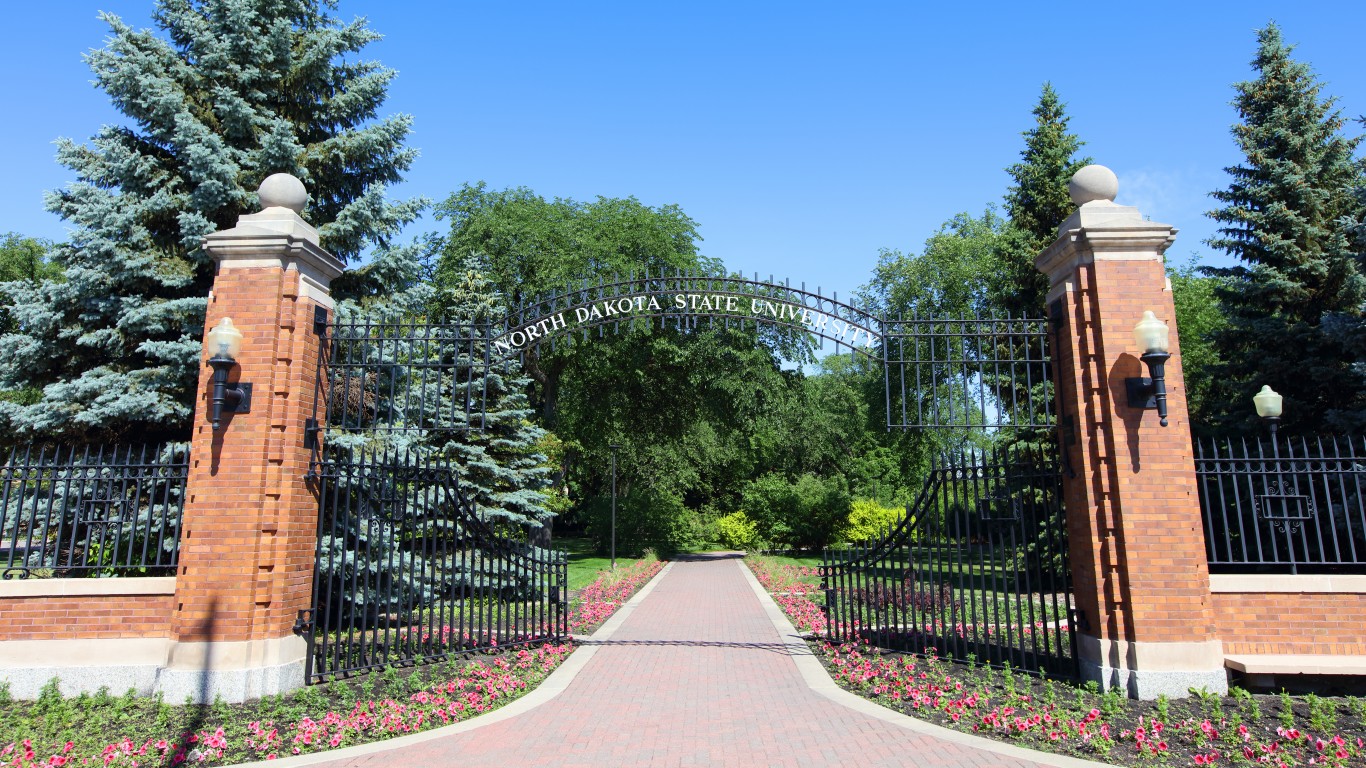
North Dakota: Fargo
> Adults with a bachelor’s degree: 39.8%
> Median household income: $63,353
> Unemployment rate: 2.4%
> Number of colleges and universities: 10
All three metro areas in North Dakota have a higher bachelor’s degree attainment rate than the 32.0% national rate. Of the three metro areas, Fargo has the highest bachelor’s degree attainment rate, at 39.8%.
A bachelor’s degree can open the door to higher paying job opportunities — and the financial gain that higher education can bring is greater in Fargo than across the state as a whole. The typical worker with a four-year college degree earns $50,860 a year in Fargo, $15,236 more than the typical high school graduate. Across North Dakota, bachelor’s degree holders earn $50,270 on average, just $14,168 more than the average worker with only a high school diploma.
[in-text-ad-2]

Ohio: Columbus
> Adults with a bachelor’s degree: 35.9%
> Median household income: $63,764
> Unemployment rate: 4.0%
> Number of colleges and universities: 59
Of the 11 metro areas in Ohio, Columbus is the only one where more than one in every three adults have at least a bachelor’s degree. A college education can insulate workers from economic slumps and make them more attractive candidates to potential employers, and in Columbus, just 4.0% of workers are out of a job, the lowest unemployment rate of any metro area in the state. Across Ohio, just 28.0% of adults have a bachelor’s degree, and the state’s unemployment rate is 4.6%.

Oklahoma: Oklahoma City
> Adults with a bachelor’s degree: 31.0%
> Median household income: $56,260
> Unemployment rate: 3.3%
> Number of colleges and universities: 42
Some 31.0% of adults in Oklahoma City have a bachelor’s degree, the most of the four metro areas in the state and well above the 25.5% of adults across the state as a whole with a four-year degree. Nationwide, workers with a bachelor’s degree earn nearly $22,000 more than high school graduates on average, and likely due in part to the population’s educational attainment, Oklahoma City is the wealthiest metro area in Oklahoma. The typical metro area household earns $56,260 a year, over $6,000 more than the median household income across the state.
[in-text-ad]
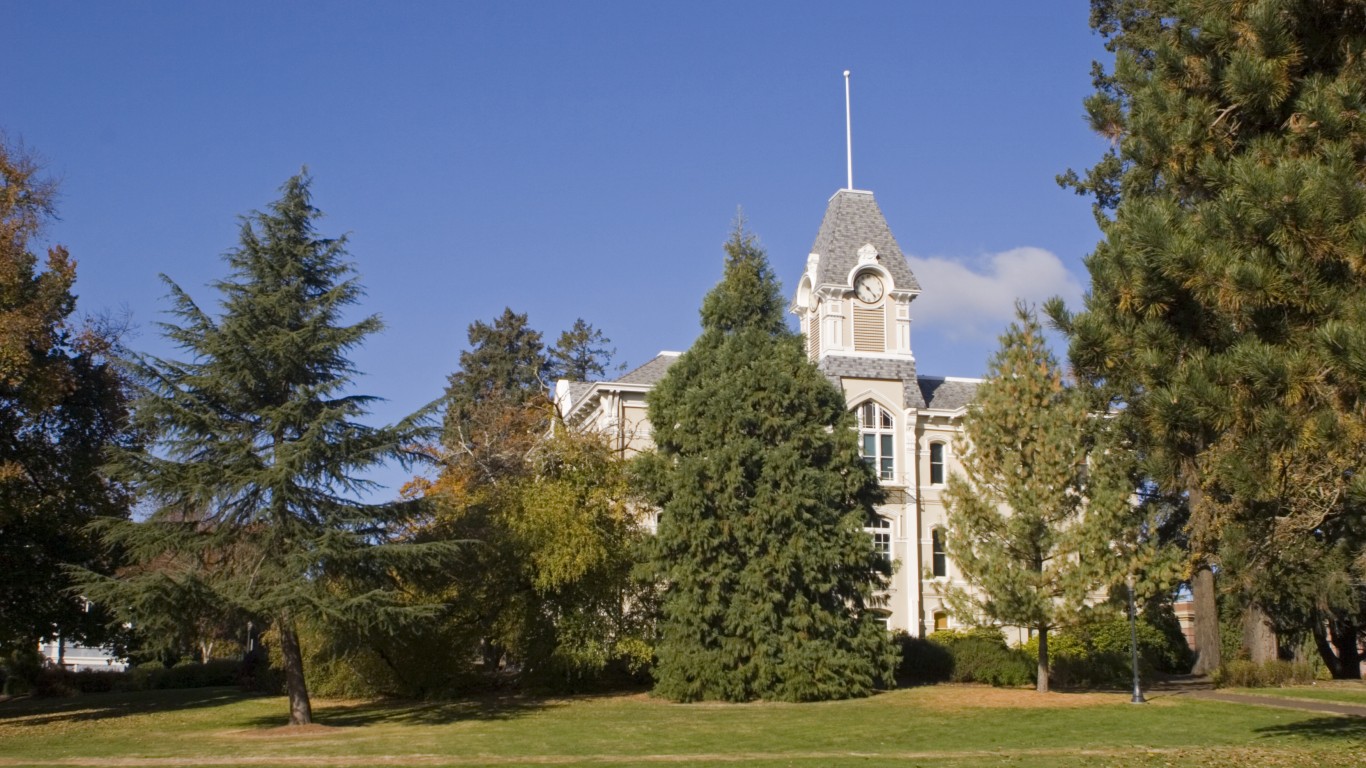
Oregon: Corvallis
> Adults with a bachelor’s degree: 53.8%
> Median household income: $60,260
> Unemployment rate: 2.7%
> Number of colleges and universities: 2
Bachelor’s degree attainment rates vary widely in Oregon’s metro areas — from 17.3% in Albany to 53.8% in Corvallis. Corvallis is the only metro area in the state — and one of just eight nationwide — where over half of all adults have a bachelor’s degree or higher.
Corvallis is home to Oregon State University, one of the largest postsecondary institutions in the state. The school, which enrolls over 5,400 graduate students, awarded nearly 6,500 degrees in 2015 alone.
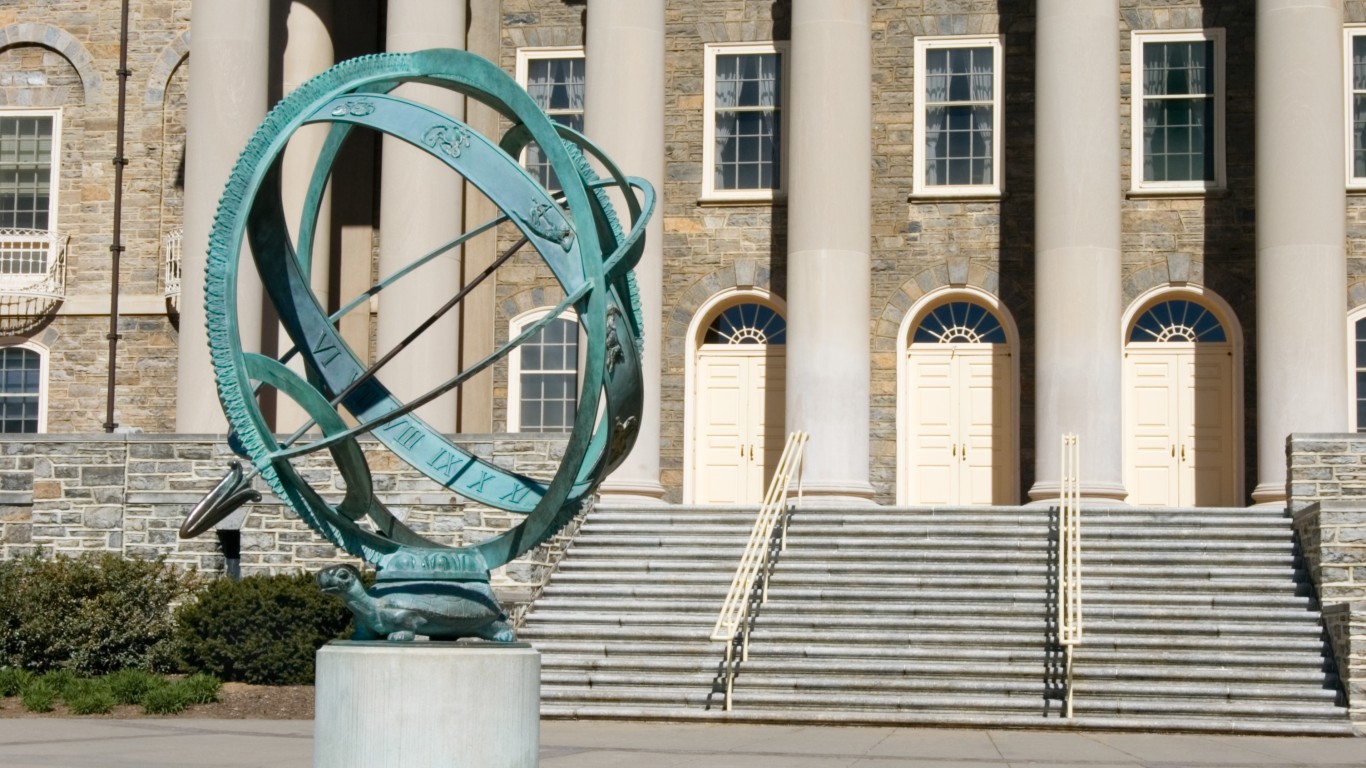
Pennsylvania: State College
> Adults with a bachelor’s degree: 45.5%
> Median household income: $55,895
> Unemployment rate: 3.1%
> Number of colleges and universities: 5
The aptly named State College metro area is home to Penn State University, the largest postsecondary institution in Pennsylvania. The area is also home to the highest concentration of college-educated adults in the state. Partially because of the nearly 2,000 educators the State College campus employs, as well as the nearly 6,000 graduate students on campus, 45.5% of adults in the metro area have a bachelor’s degree or higher. Across Pennsylvania as a whole, 31.4% of adults have a four-year college degree.

Rhode Island: Providence-Warwick
> Adults with a bachelor’s degree: 31.9%
> Median household income: $65,226
> Unemployment rate: 4.0%
> Number of colleges and universities: 37
The only metro area in Rhode Island, Providence-Warwick is the best educated city in the state by default only. In fact, the area’s 31.9% bachelor’s degree attainment rate is slightly below the statewide rate of 33.5%.
Still, Rhode Island’s only metro area is something of a higher education hub. The Providence-Warwick metro area is home to the three largest postsecondary educational institutions in Rhode Island: the University of Rhode Island, Johnson and Wales University – Providence, and Brown University. The 37 total higher education institutions across the metro area issued nearly 27,000 degrees in 2015 alone.
[in-text-ad-2]

South Carolina: Hilton Head Island-Bluffton-Beaufort
> Adults with a bachelor’s degree: 37.8%
> Median household income: $55,430
> Unemployment rate: 3.1%
> Number of colleges and universities: 2
Educational attainment rates in South Carolina are not especially high, as just 28.0% of adults in the state have at least a bachelor’s degree, compared to 32.0% of adults nationwide. Areas with higher educational attainment often report higher incomes, and while Hilton Head Island-Bluffton-Beaufort — the most educated metro area in South Carolina — is not the wealthiest area in the state, it has the lowest poverty and extreme poverty rates. Across the Hilton Head area, 4.3% of households earn less than $10,000 a year, and 10.9% of the population lives in poverty — each the smallest shares of any metro area in the state. For reference, 6.5% of American households earn less than $10,000 a year and 13.4% of the U.S. population lives in poverty.
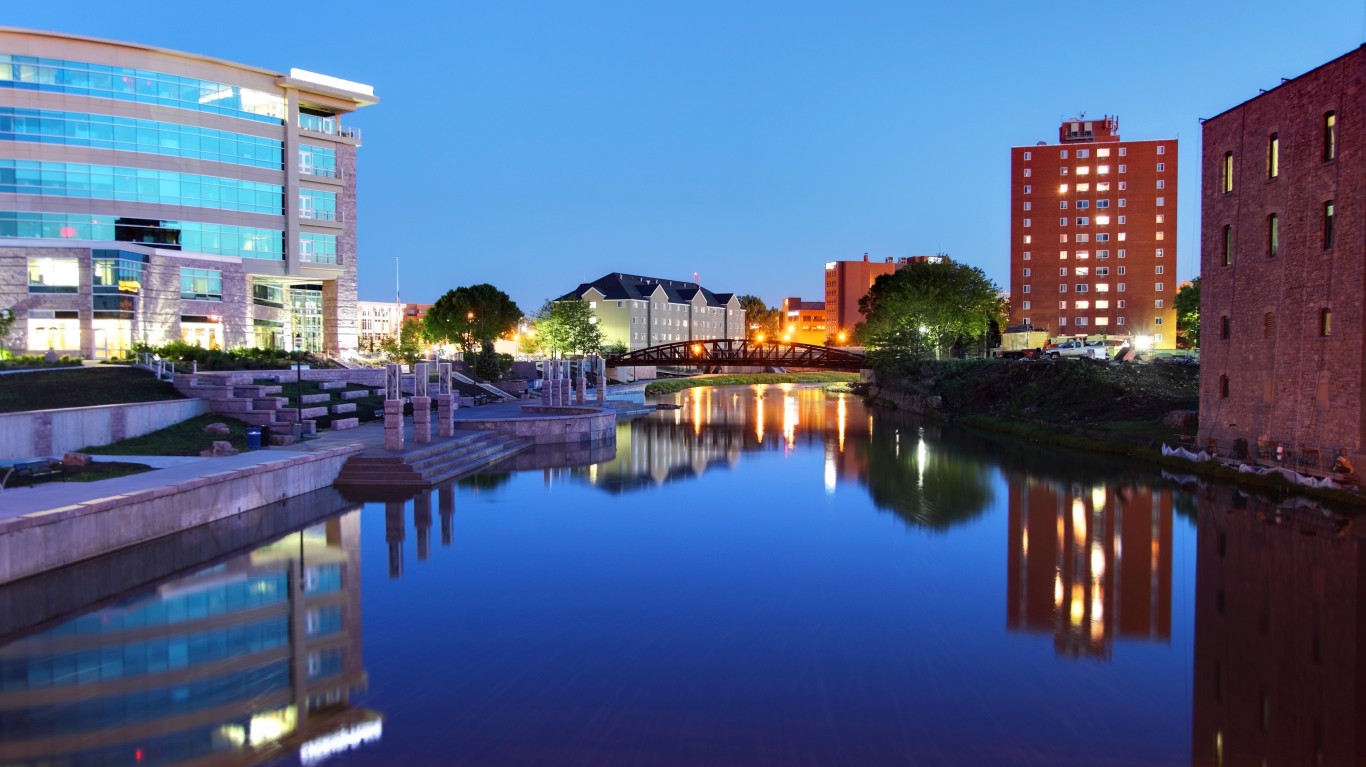
South Dakota: Sioux Falls
> Adults with a bachelor’s degree: 32.2%
> Median household income: $64,882
> Unemployment rate: 2.4%
> Number of colleges and universities: 11
In Sioux Falls, 32.2% of adults have a bachelor’s degree or higher, more than the 28.6% of adults in Rapid City, the only other metro area in South Dakota. Workers with a bachelor’s degree benefit financially to a greater degree in Sioux Falls than those living in Rapid City. College-educated workers earn $47,702 a year on average in Sioux Falls, $16,465 more than than those with only a high school diploma. Meanwhile, workers with a four-year college degree in Rapid City earn $41,321 a year on average, just $12,031 more than workers with just a high school education do.
[in-text-ad]

Tennessee: Nashville-Davidson–Murfreesboro–Franklin
> Adults with a bachelor’s degree: 36.0%
> Median household income: $63,939
> Unemployment rate: 2.8%
> Number of colleges and universities: 56
Educational attainment rates range considerably in Tennessee. In the Morristown metro area, 14.9% of adults have a bachelor’s degree, while in the Nashville metro area, 36.0% of adults do. The high educational attainment in Nashville is driven by the presence of higher education institutions and employers in high-skill industries.
Both Middle Tennessee State University and Vanderbilt University — two of the largest schools in the state — are located in the Nashville metro area. Additionally, a higher share of area workers are employed in finance as well as professional and business services compared to the vast majority of U.S. metro areas.

Texas: Austin-Round Rock
> Adults with a bachelor’s degree: 44.8%
> Median household income: $73,800
> Unemployment rate: 2.8%
> Number of colleges and universities: 43
Bachelor’s degree attainment rates vary widely in Texas, from as little as 13.9% in the Odessa metro area to 44.8% in the Austin-Round Rock metro area. As is the case in many cities on this list, the state’s most educated metro area is also home to the largest university in the state. The University of Texas at Austin enrolls 11,163 graduate students in addition to 3,128 teaching faculty members.
In addition to academia, the Austin area also has a higher concentration of workers employed in a number of other industries that generally require at least a college education and pay relatively well, including finance and professional and business services.

Utah: Provo-Orem
> Adults with a bachelor’s degree: 41.3%
> Median household income: $70,196
> Unemployment rate: 2.9%
> Number of colleges and universities: 18
Utah’s 34.6% bachelor’s degree attainment rate exceeds the comparable national rate of 32.0%. In the Provo-Orem metro area, educational attainment is even higher. Some 41.3% of adults in the area have at least a bachelor’s degree, the largest share among the state’s five metro areas.
Like many other cities on this list, the Provo-Orem metro area is home to a major research university. The Brigham Young University Provo campus is one of the largest postsecondary institutions in the state, awarding nearly half of the 16,408 degrees the 18 higher education institutions in the state issued in 2015.
[in-text-ad-2]
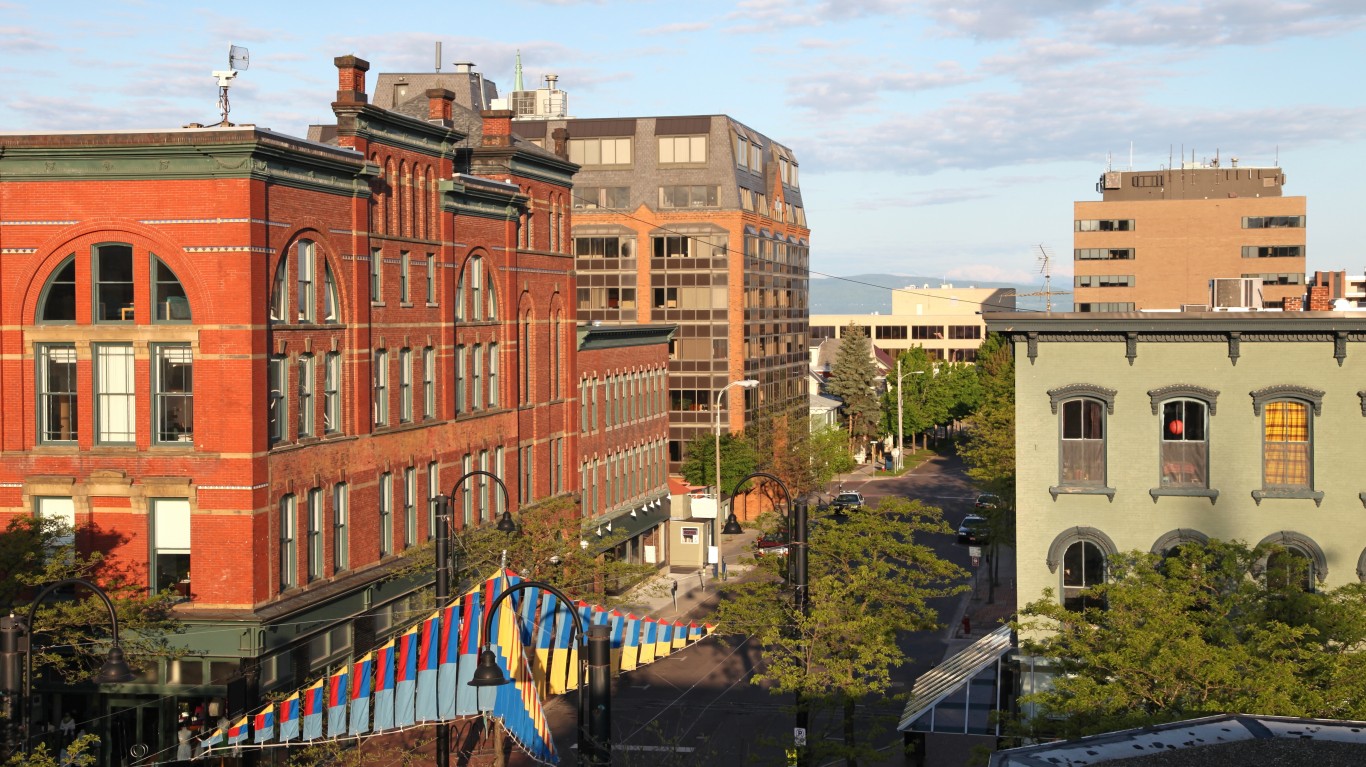
Vermont: Burlington-South Burlington
> Adults with a bachelor’s degree: 43.0%
> Median household income: $63,160
> Unemployment rate: 2.3%
> Number of colleges and universities: 8
The only metro area in Vermont, Burlington-South Burlington ranks as the state’s most educated city by default. Still, the superlative is not undeserved as 43.0% of adults have a bachelor’s degree, more than the 38.3% of adults in Vermont and the 32.0% of adults nationwide. Only three metro areas in the broader New England region have a higher bachelor’s degree attainment rate.
The Burlington-South Burlington has similar qualities found in many other cities on this list, including a low unemployment rate, a high median household income, and the presence of a major university — the University of Vermont in this case.
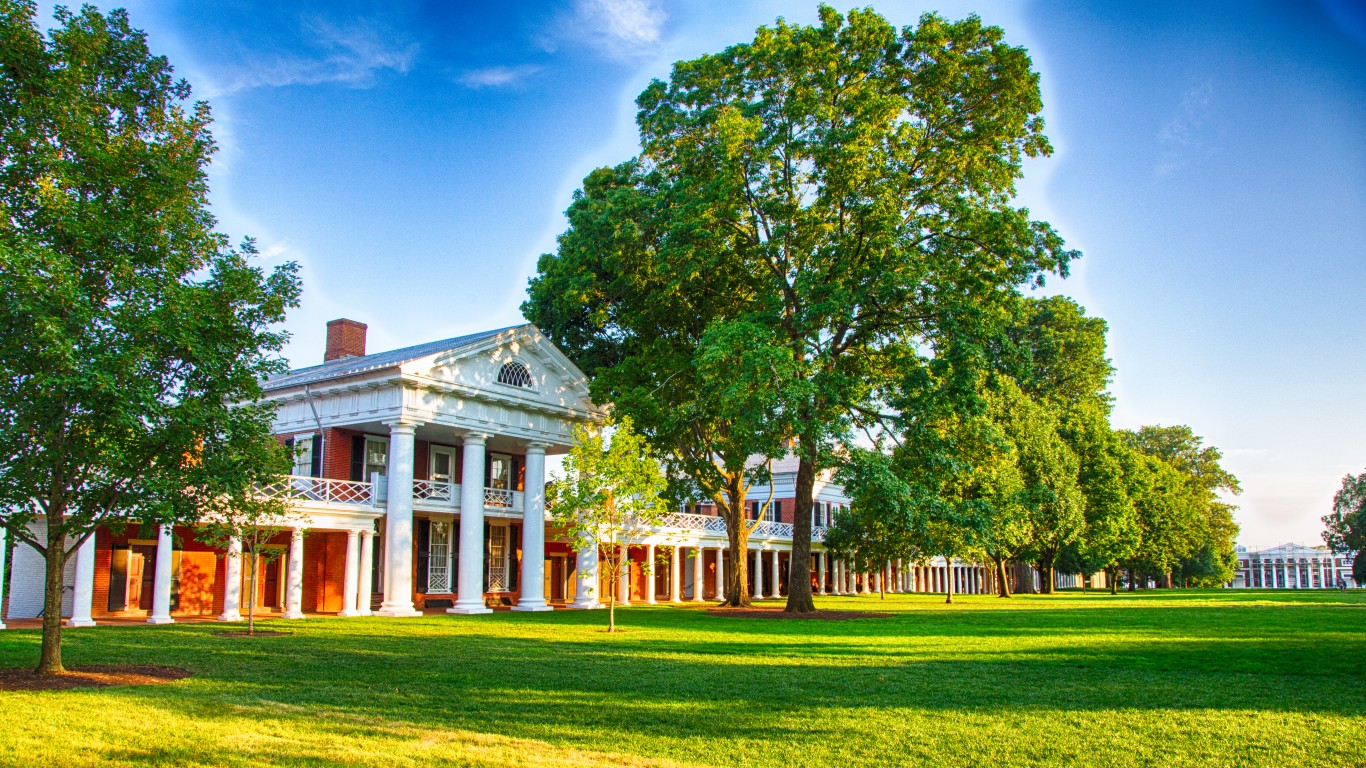
Virginia: Charlottesville
> Adults with a bachelor’s degree: 46.0%
> Median household income: $66,853
> Unemployment rate: 2.5%
> Number of colleges and universities: 3
Charlottesville is far and away the most highly educated city in Virginia. Charlottesville’s 46.0% bachelor’s degree attainment rate is nearly 10 percentage points higher than the 36.8% rate in Richmond, the city with the next highest college attainment rate in the state. The Charlottesville metro area metro area is home to three postsecondary education institutions, most notably the University of Virginia.
College graduates in Charlottesville benefit financially from their education more than graduates in most other areas in the state. The average salary for workers with a four-year degree in the area is $50,849 a year, $23,010 more than the average salary for workers with only a high school diploma — the largest difference of any metro area in the state.
[in-text-ad]

Washington: Seattle-Tacoma-Bellevue
> Adults with a bachelor’s degree: 41.9%
> Median household income: $82,133
> Unemployment rate: 3.7%
> Number of colleges and universities: 68
In Seattle-Tacoma-Bellevue, 41.9% of adults have a bachelor’s degree, by far the largest share of any metro area in the state. For reference, 35.5% of adults across Washington state have a bachelor’s degree or higher.
Greater educational attainment often leads to higher incomes, and wealth is concentrated in the Seattle metro area to a greater degree than anywhere else in the state. Some 12.0% of area households earn at least $200,000 a year. The next highest concentration of wealth in Washington is in the Bremerton-Silverdale metro area, where just 6.3% of households earn $200,000 or more a year.
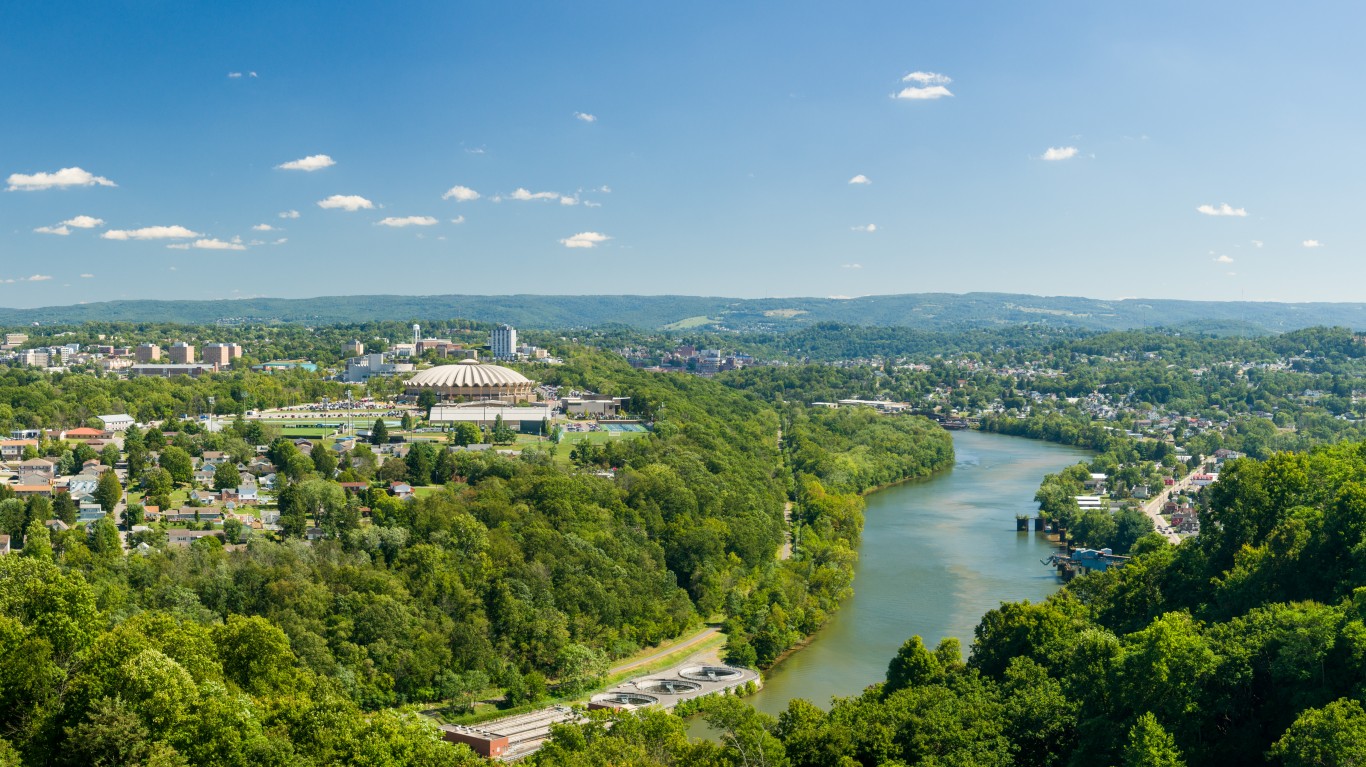
West Virginia: Morgantown
> Adults with a bachelor’s degree: 34.0%
> Median household income: $49,475
> Unemployment rate: 4.5%
> Number of colleges and universities: 7
Morgantown is far and away the best-educated metro area in West Virginia. In Morgantown, 34.0% of adults have a bachelor’s degree or higher, more than 10 percentage points greater than the 23.3% share of adults with a bachelor’s degree in Charleston, the metro area with the second highest bachelor’s degree attainment rate in the state. Across West Virginia as a whole, 20.2% of adults have a four-year college education, the lowest share of any state.
Like many other cities on this list, Morgantown is home to a major research university. West Virginia University enrolls more than 28,000 undergrad and graduate students and employs 2,700 instructional faculty members.
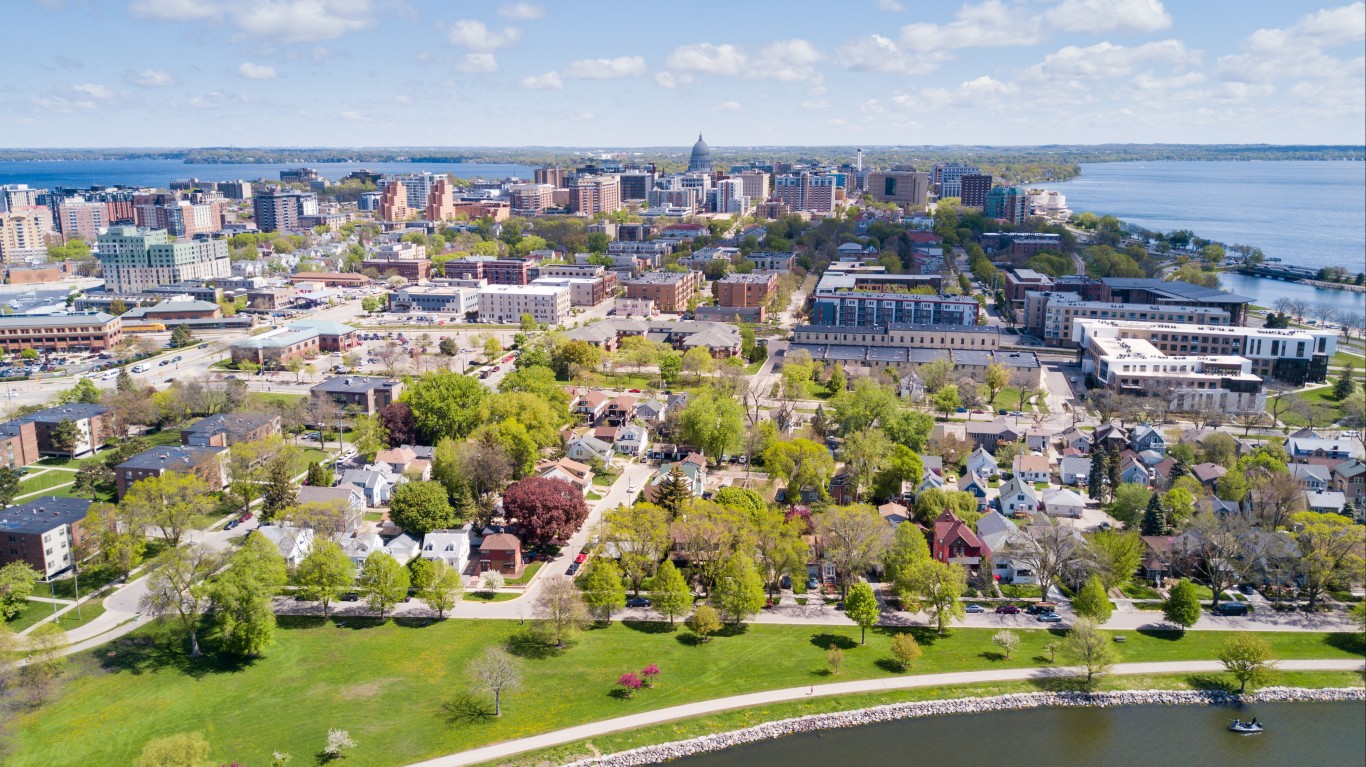
Wisconsin: Madison
> Adults with a bachelor’s degree: 45.9%
> Median household income: $71,301
> Unemployment rate: 2.3%
> Number of colleges and universities: 17
The University of Wisconsin’s flagship campus is located in the state capital of Madison. U of W Madison, which enrolls nearly 9,000 additional graduate students, awarded 12,400 degrees in 2015 alone. Partially as a result, the Madison metro area’s bachelor’s degree attainment rate of 45.9% is the highest of any metro area in the state and fifth highest in the Midwest.
Areas with greater educational attainment tend to report higher incomes, and Madison is no exception. The typical metro area household earns $71,301 a year, by far the most of any metro area in the state. For reference, 30.4% of adults statewide have a bachelor’s degree, and the typical Wisconsin household earns $59,305 a year.
[in-text-ad-2]
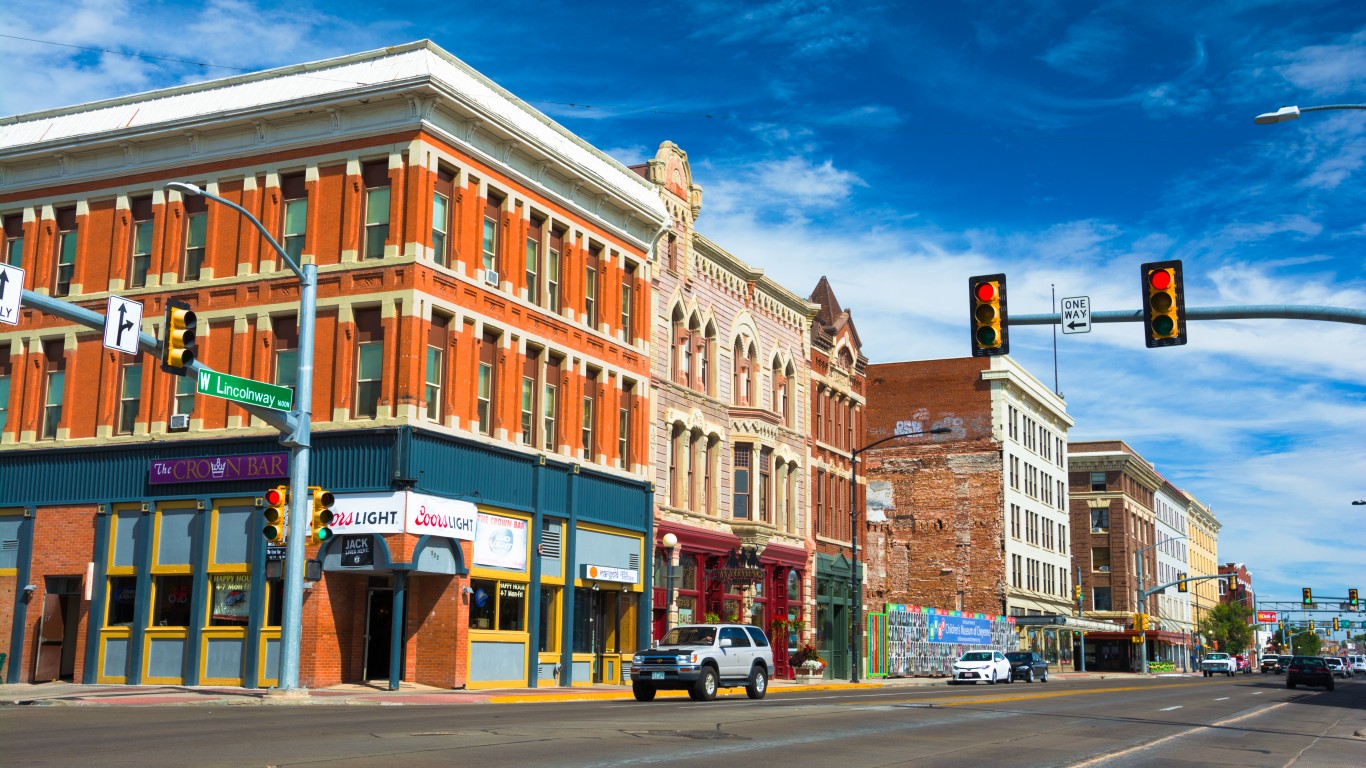
Wyoming: Cheyenne
> Adults with a bachelor’s degree: 27.9%
> Median household income: $61,961
> Unemployment rate: 3.9%
> Number of colleges and universities: 4
Cheyenne’s bachelor’s degree attainment rate of 27.9% is well above Casper’s bachelor’s degree attainment rate of 24.2% — Casper is Wyoming’s only other metro area. College-educated adults often are better candidates for potential employers, and Cheyenne’s 3.9% unemployment rate is lower than Casper’s 4.6% unemployment rate.
A bachelor’s degree can open the door to higher paying job opportunities — and the financial gain that higher education can bring is greater in Cheyenne than across the state as a whole. The typical worker with a four-year college degree earns $47,421 a year in Cheyenne, $20,671 more than the typical high school graduate. Across Wyoming, bachelor’s degree holders earn $47,546 on average, just $16,399 more than the earnings of the average worker with only a high school diploma.
Detailed Findings
Every metro area on this list is home to at least two higher education institutions. In many cases, the city with the highest bachelor’s degree attainment rate is also home to the largest research university in the state — and this is no coincidence. Postsecondary institutions employ highly educated instructors and researchers, award hundreds if not thousands of degrees a year, and often offer graduate programs for which a bachelor’s degree is a precondition to enrollment.
Cities on this list where high educational attainment is driven by the presence of a large university include: Ames, Iowa; Ann Arbor, Michigan; Bloomington, Indiana; Chapel Hill, North Carolina; and Ithaca, New York.
Cities with large shares of college-educated adults also often have economies with high concentrations of professional and business service occupations, as well as other high-skill industries such as finance. Companies offering jobs that require a college education will often choose to operate in a city with a well-educated population for better access to qualified workers. Similarly, college graduates will often choose to live in a city where they can more easily leverage their education to secure a job.
Jobs that require a college degree are often higher paying than those with lower educational requirements. Partially as a result, incomes tend to be high in highly-educated cities. In 38 of of the 50 cities on this list, the typical household earns more than than the median household income in the state as a whole.
Just because a city ranks as the best-educated in its state does not mean it is well-educated relative to the nation as a whole. In 10 states, the most educated city is home to a smaller share of adults with bachelor’s degrees than the 32.0% national share.
In rare cases, the most highly-educated metro area in a state has a lower bachelor’s degree attainment rate than the state itself. Often, these cities are the only major metro area in the state, and rank as the best educated by default. Providence, Rhode Island and Manchester, New Hampshire are two examples.
Methodology
To identify the most educated city in every state, 24/7 Wall St. reviewed the percentages of metro area adults who have earned at least a bachelor’s degree in every state. The bachelor’s degree attainment rate and high school diploma attainment rate, along with income and the percentage of households receiving SNAP benefits for metro areas and for states all came from the U.S. Census Bureau’s 2017 American Community Survey. Shares of each metro’s workforce employed in particular industries came from the Bureau of Labor Statistics. Unemployment figures are also from the BLS and are for July 2018. The number of postsecondary institutions in each metropolitan area came from the U.S. Department of Education. Postsecondary institutions include four-year and two-year universities and colleges, as well as technical institutes and trade academies. The Washington-Arlington-Alexandria metro area, which spans the District of Columbia, Virginia, Maryland, and West Virginia, was excluded from the ranking.
It’s Your Money, Your Future—Own It (sponsor)
Retirement can be daunting, but it doesn’t need to be.
Imagine having an expert in your corner to help you with your financial goals. Someone to help you determine if you’re ahead, behind, or right on track. With SmartAsset, that’s not just a dream—it’s reality. This free tool connects you with pre-screened financial advisors who work in your best interests. It’s quick, it’s easy, so take the leap today and start planning smarter!
Don’t waste another minute; get started right here and help your retirement dreams become a retirement reality.
Thank you for reading! Have some feedback for us?
Contact the 24/7 Wall St. editorial team.
 24/7 Wall St.
24/7 Wall St. 24/7 Wall St.
24/7 Wall St. 24/7 Wall St.
24/7 Wall St.



